Kinesiology Final - GAIT
1/179
There's no tags or description
Looks like no tags are added yet.
Name | Mastery | Learn | Test | Matching | Spaced |
|---|
No study sessions yet.
180 Terms
What are spatial descriptors of gait?
Stride length
Step length
Step width
Foot angle
What is stride length? What is average?
Initiated at foot contact with ground: heel contact/strike (heel strike to next heel strike on the same side)
stride length = 144 cm
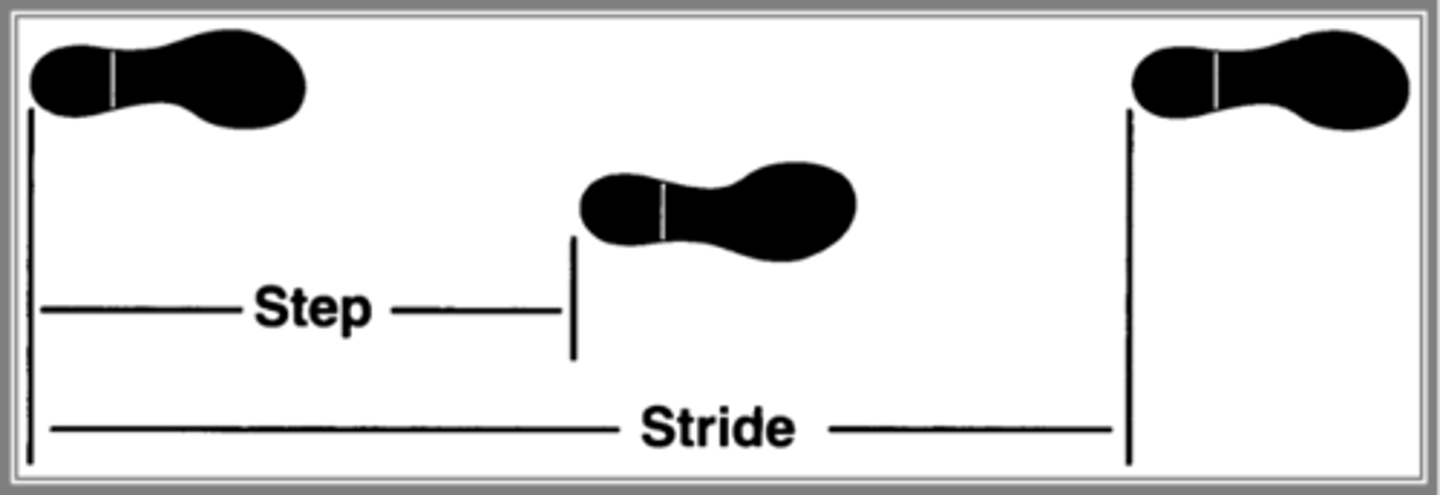
What is step length? What is average?
distance between heel contact on one side to heel contact on opposite side.
step length = 72 cm
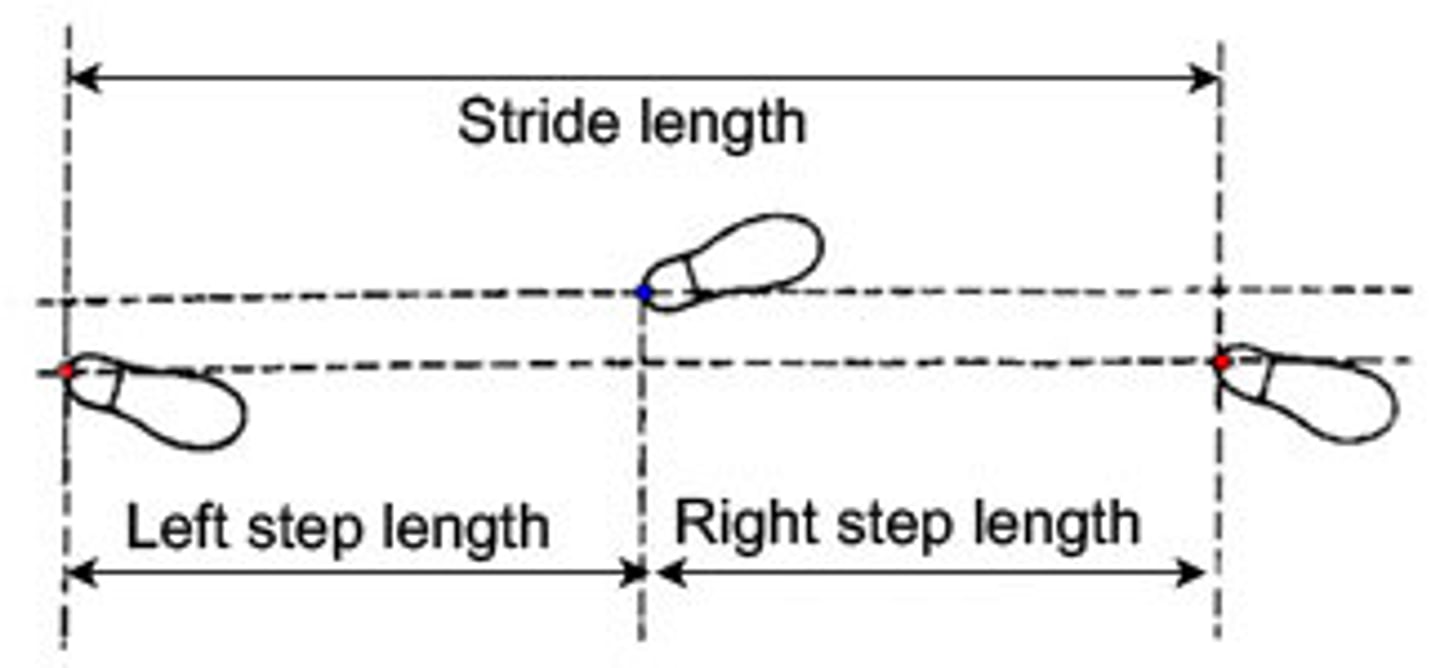
What is step width? What is average?
how far apart the feet are. average is 8-10 cm
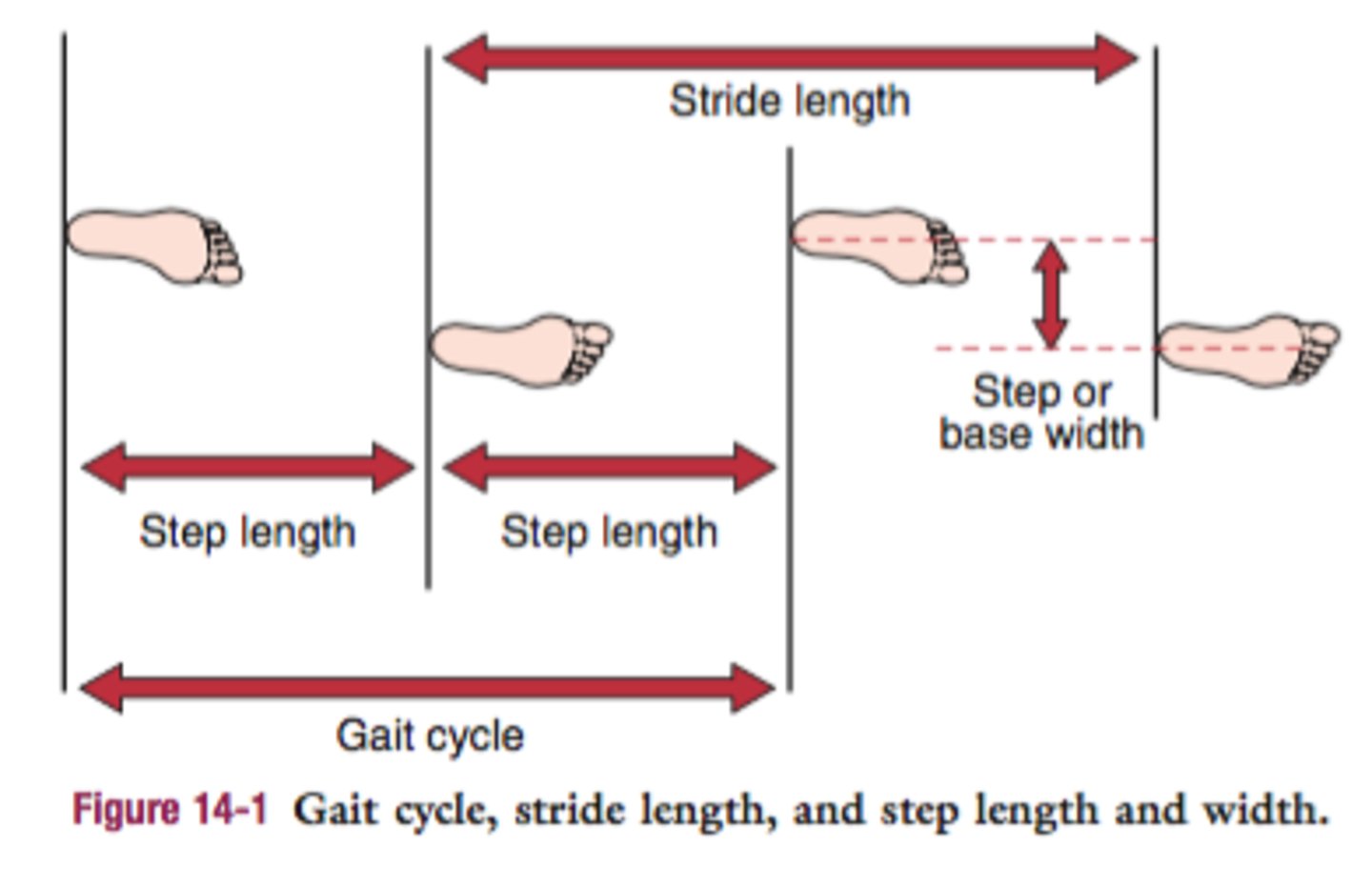
What is foot angle? What is average?
Amount of toe out. average is 5-7 degrees
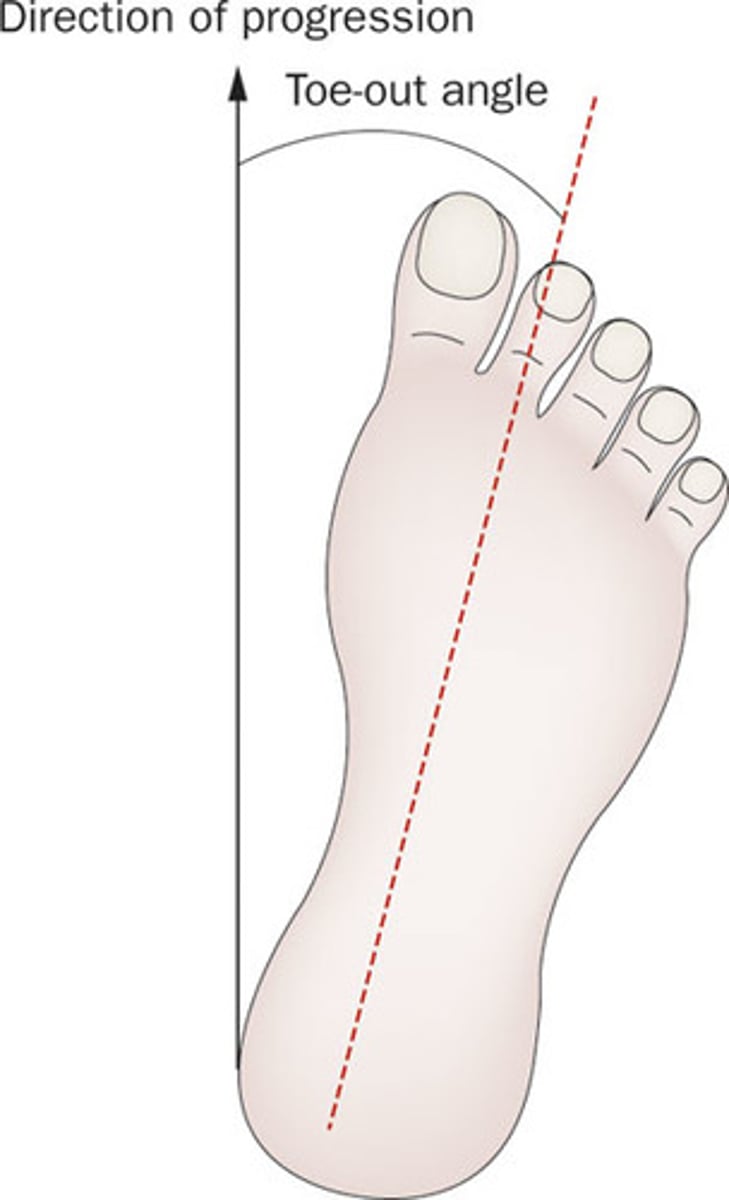
What are temporal descriptors of gait?
-cadence/step rate
-stride time
-step time
What is cadence?
steps per minute
What is stride time?
time for a full gait cycle
What is step time?
time for the completion of a right or a left step
What is the most functional measure of walking ability?
walking speed (distance covered in a given amount of time)
What are normal walking values (walking speed, step rate, and step length)?
Walking speed: 1.37 m/sec (3mph)
Step rate: 1.87 steps/sec (110 steps/min)
Step length: 72 cm (28 inches)
What are ways to increase walking speed?
-increase stride, or step length
-increase cadence
-typically both strategies used
What are the two major phases of gait? What percentage of the gait cycle are they?
Stance phase = 60%
Swing phase = 40%
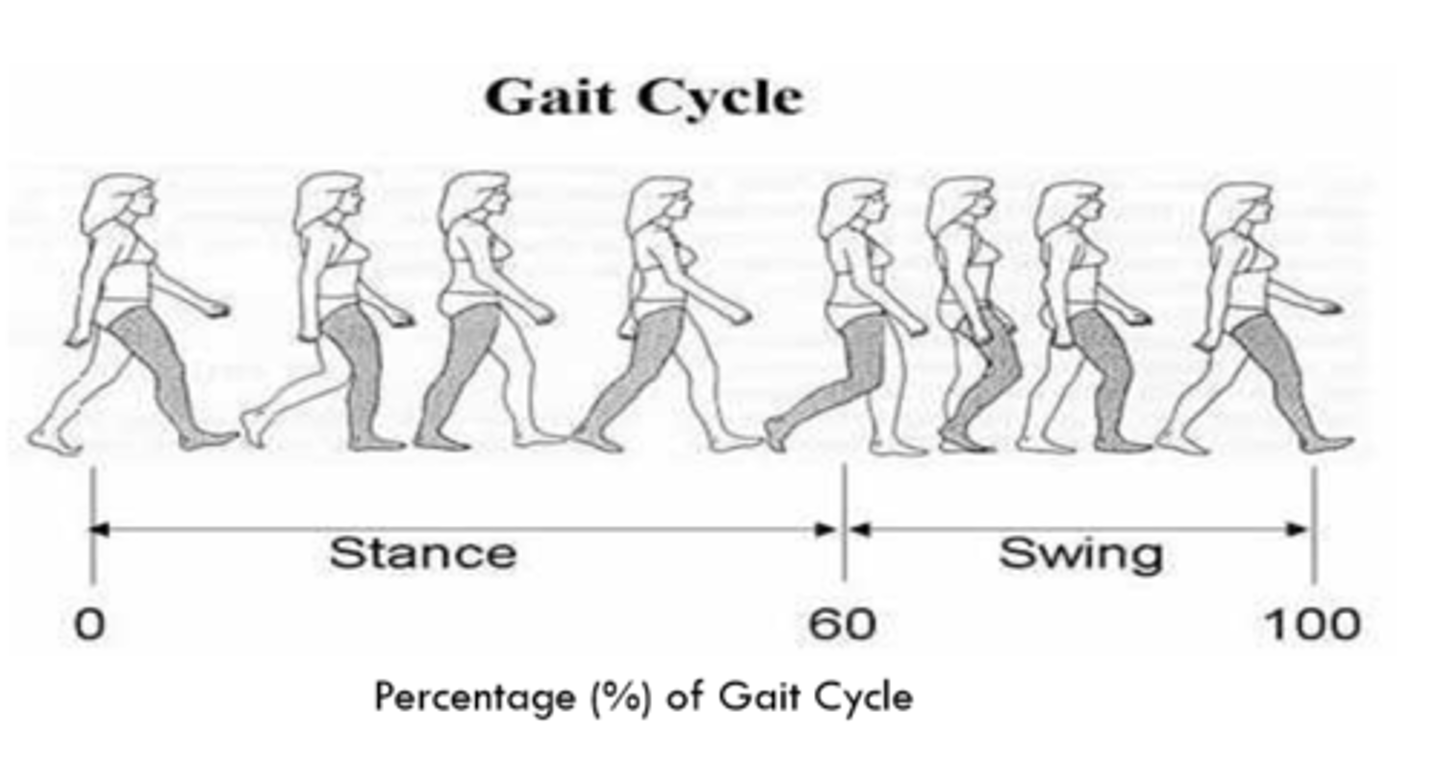
At what percentages of the gait cycle do the two periods of double limb support occur?
0-10%
50-60%
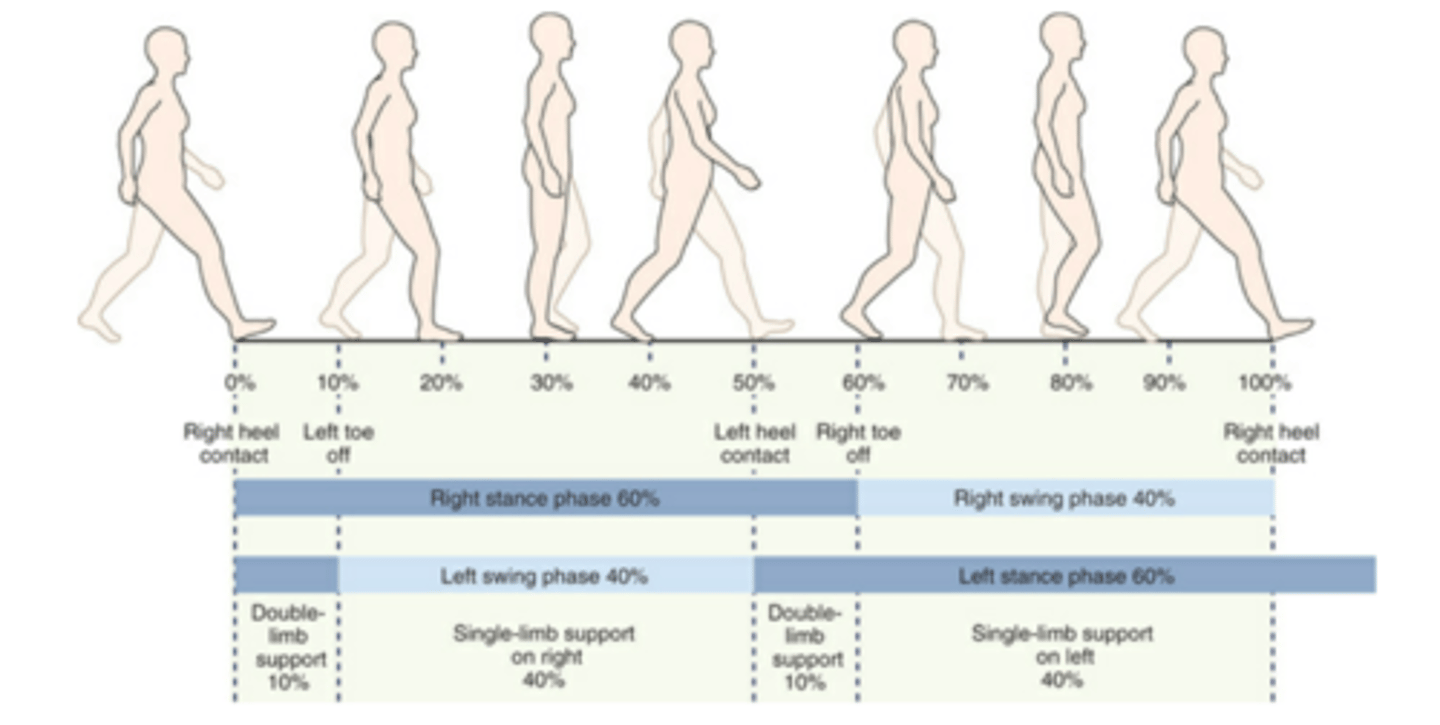
At what percentages of the gait cycle do the two periods of single limb support occur?
10-50%
60-100%
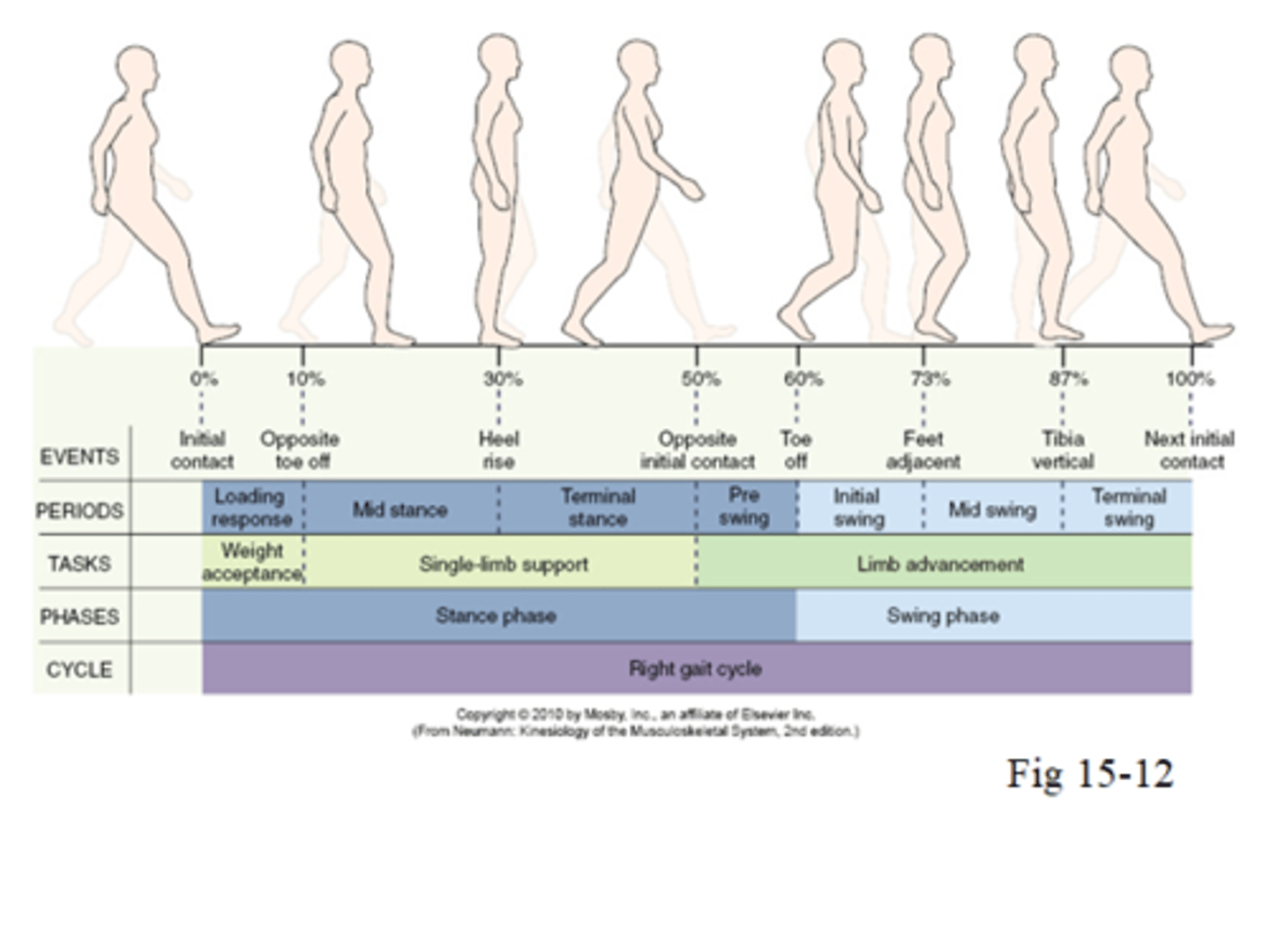
As gait speed increases, % of double-limb support becomes ______
shorter
What happens to the division of the gait cycle with running?
double-limb support phase disappears and is replaced by flight phase
What are the eight events of the gait cycle?
1. initial contact
2. opposite toe off
3. heel rise
4. opposite initial contact
5. toe off
6. feet adjacent
7. tibia vertical
8. initial contact
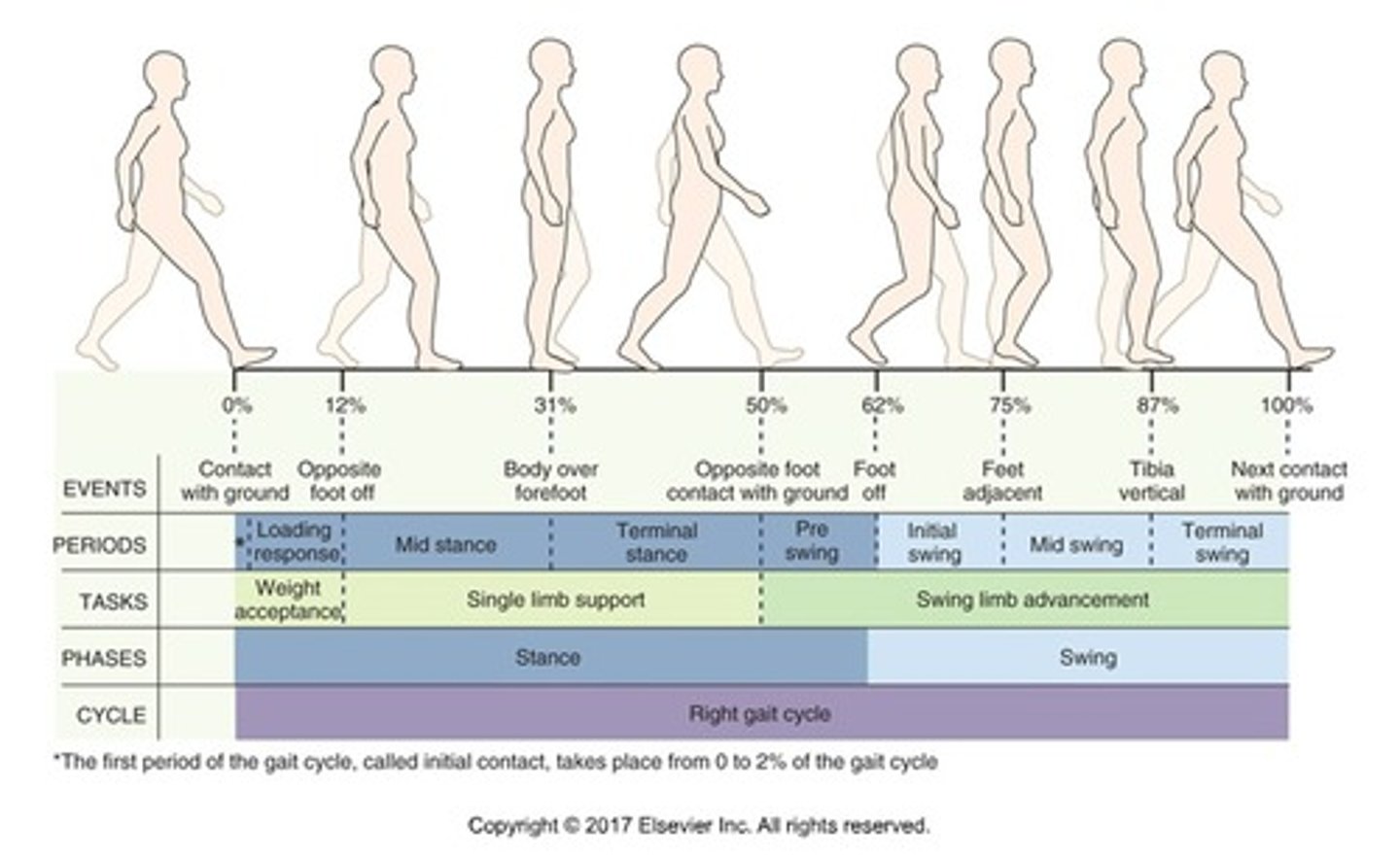
What are the seven period of the gait cycle?
Four during stance phase
1. loading response
2. midstance
3. terminal stance
4. pre-swing
Three during swing phase
5. initial swing
6. mid swing
7. terminal swing
COM displacement often tracked by _____ or ______ displacement with walking.
head or trunk
What are the three directions of displacement?
-forward
-vertical: 5 cm
-side to side: 4cm

The body ______ and ______ with each step
slows down and speeds up (kinetic and potential energy considerations)
At what part of the gait cycle is the velocity the lowest? What what part is the velocity the highest?
Lowest velocity: mid stance
highest velocity: double-limb support
Kinetic energy =
0.5 mv^2 (related to movement)
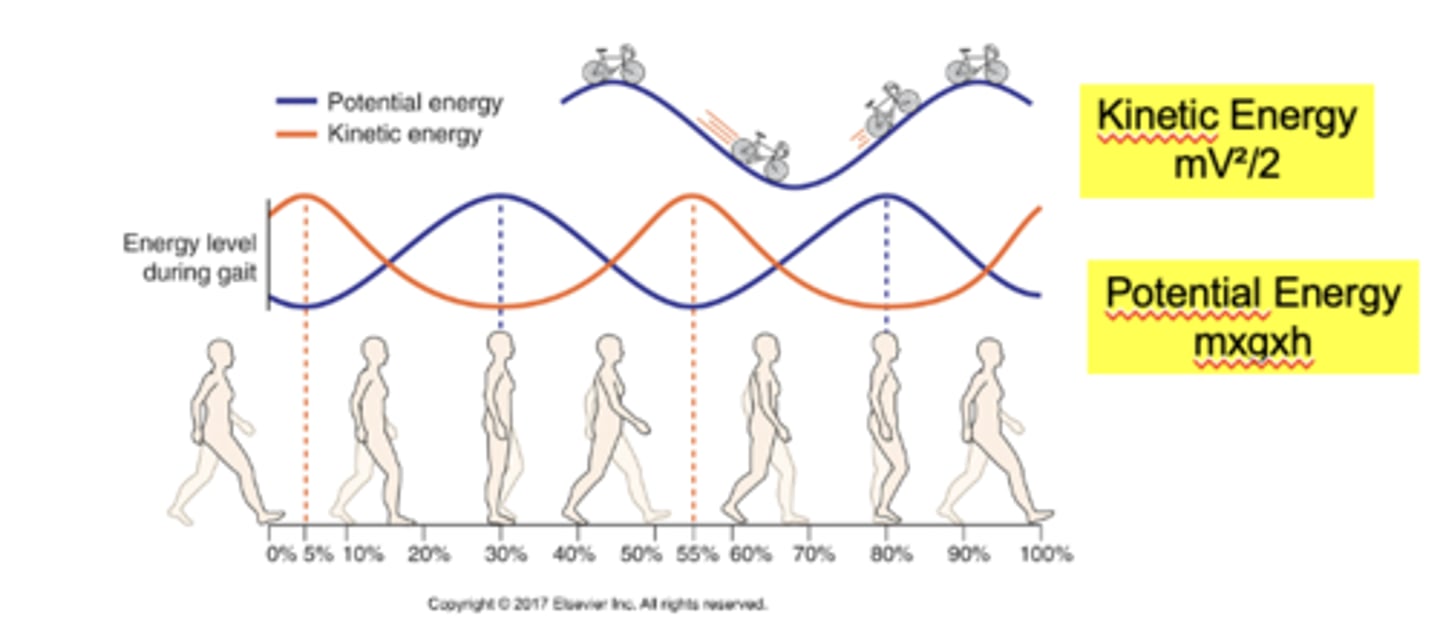
potential energy =
mgh (related to height)

What are the kinematics of the pelvis in the sagittal plane during gait?
total of approximately 2-4 degrees of ant/post tilt
tilting increases with speed of ambulation
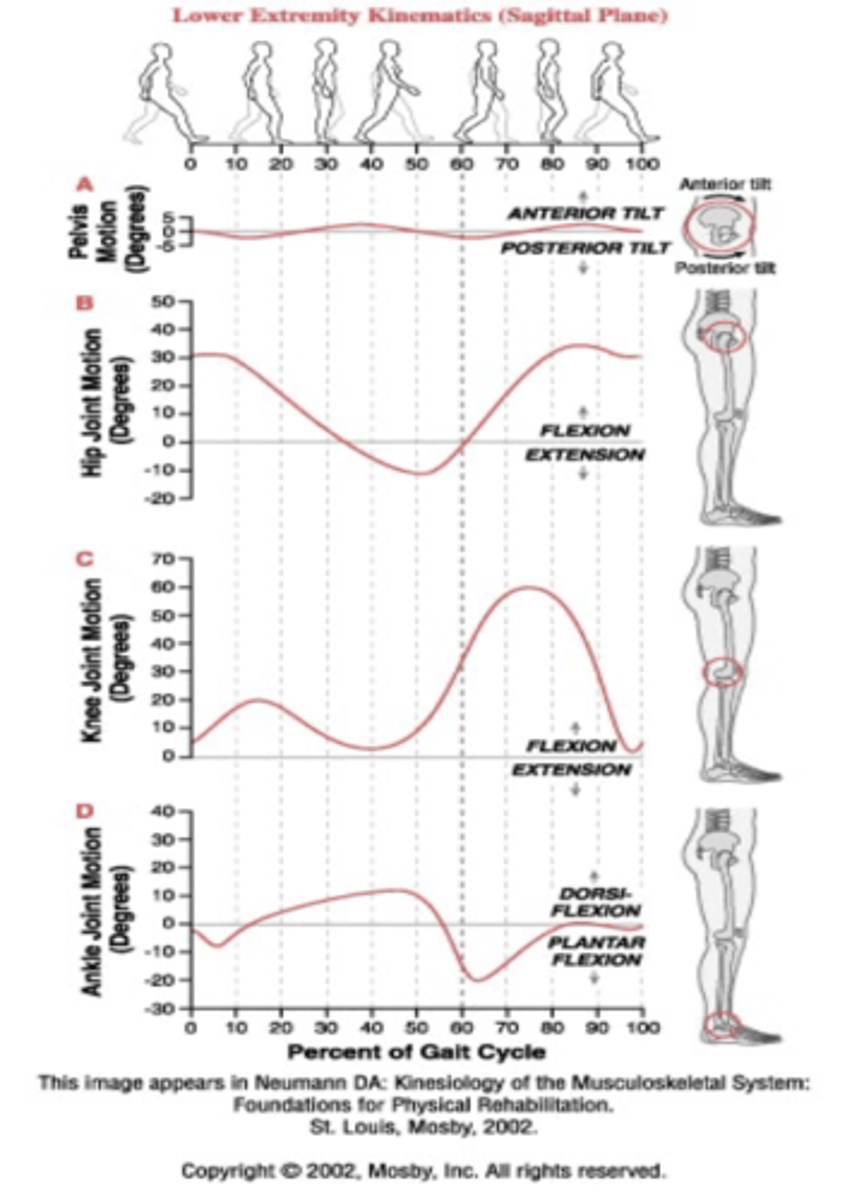
What are the kinematics of the hip in the sagittal plane during gait?
flexed 30 degrees at heel contact
extended 10 degrees before toe off
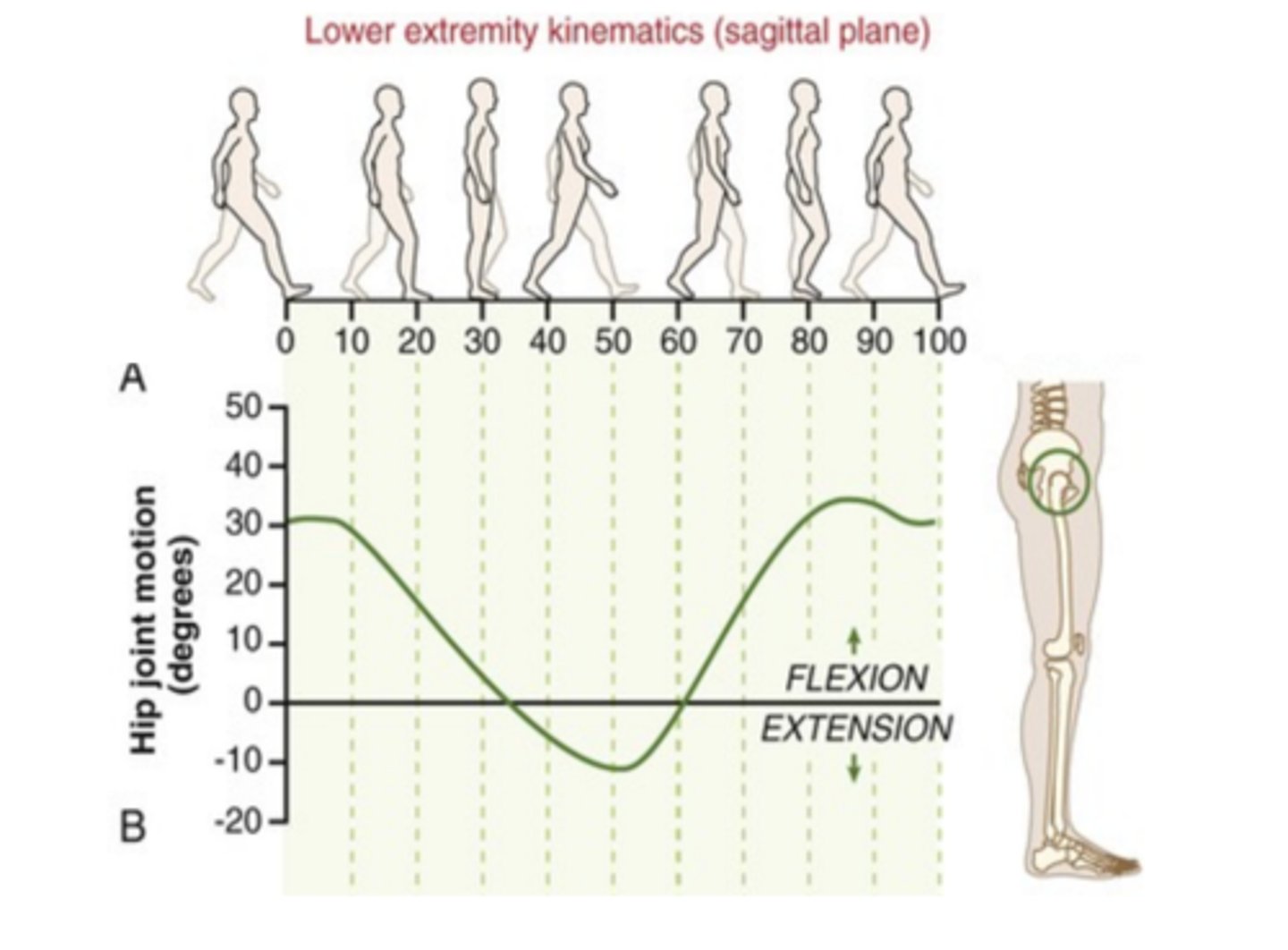
How could a pt with a lack of passive hip extension compensate?
anterior tilt with associated lumbar lordosis can compensate for lack of passive hip extension
How could a pt with a lack of hip flexion compensate?
posterior pelvic tilt with flattening of lumbar spine compensated for lack of hip flexion
What are the kinematics of the knee in the sagittal plane during gait?
heel contact: 5 deg flexion
-continues to flex 10-15 degrees more
-shock absorption and weight acceptance
mid stance through heel off: near full extension
toe off: 35 deg flexion
mid swing: maximum knee flexion of 60 deg (functional measures)
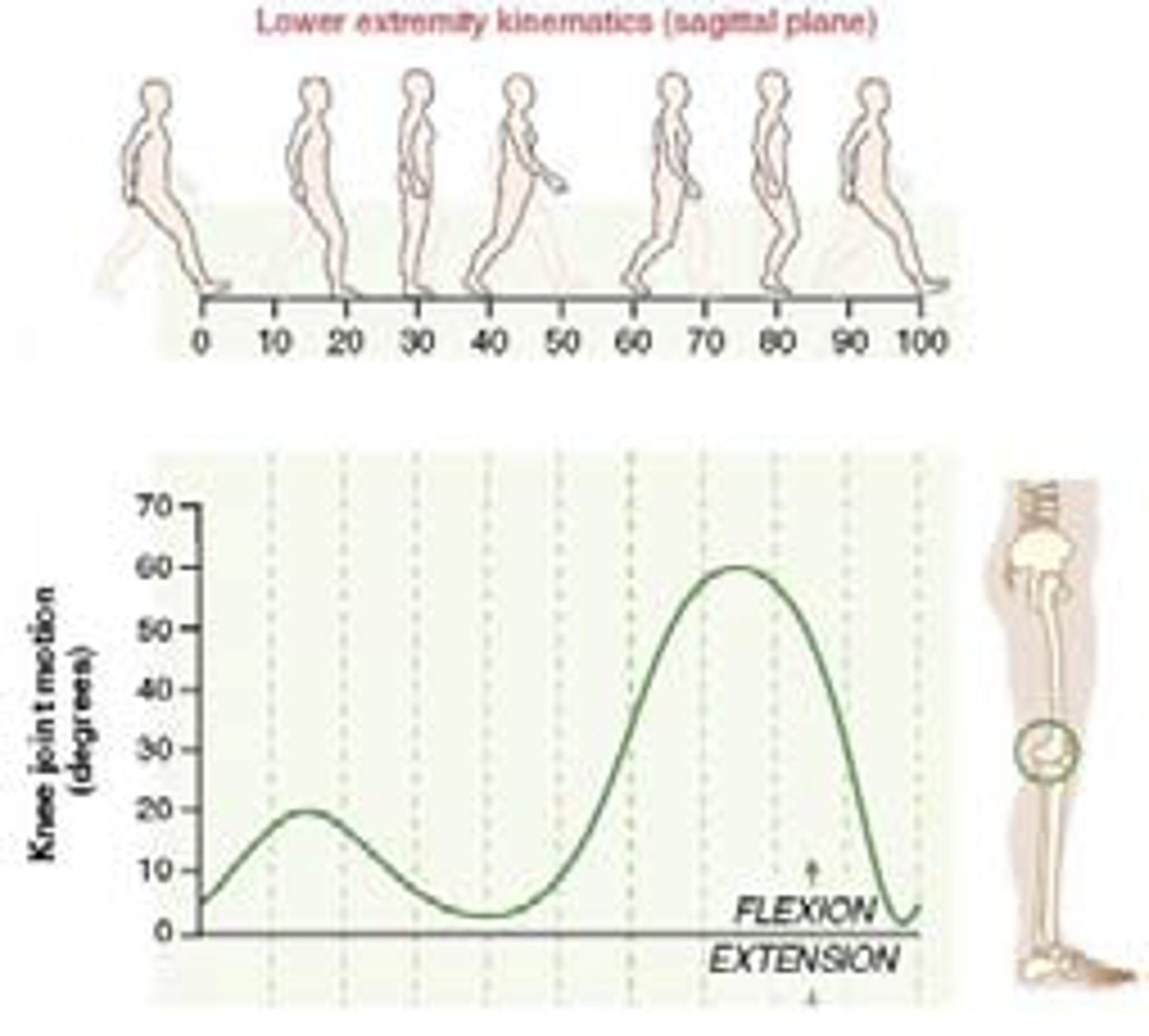
What are the kinematics of the ankle in the sagittal plane during gait?
heel contact: slight plantar flexion
-eccentrically controlled descent of foot to flat on ground
stance: 10 deg dorsiflexion needed
toe off: 20 deg plantarflexion
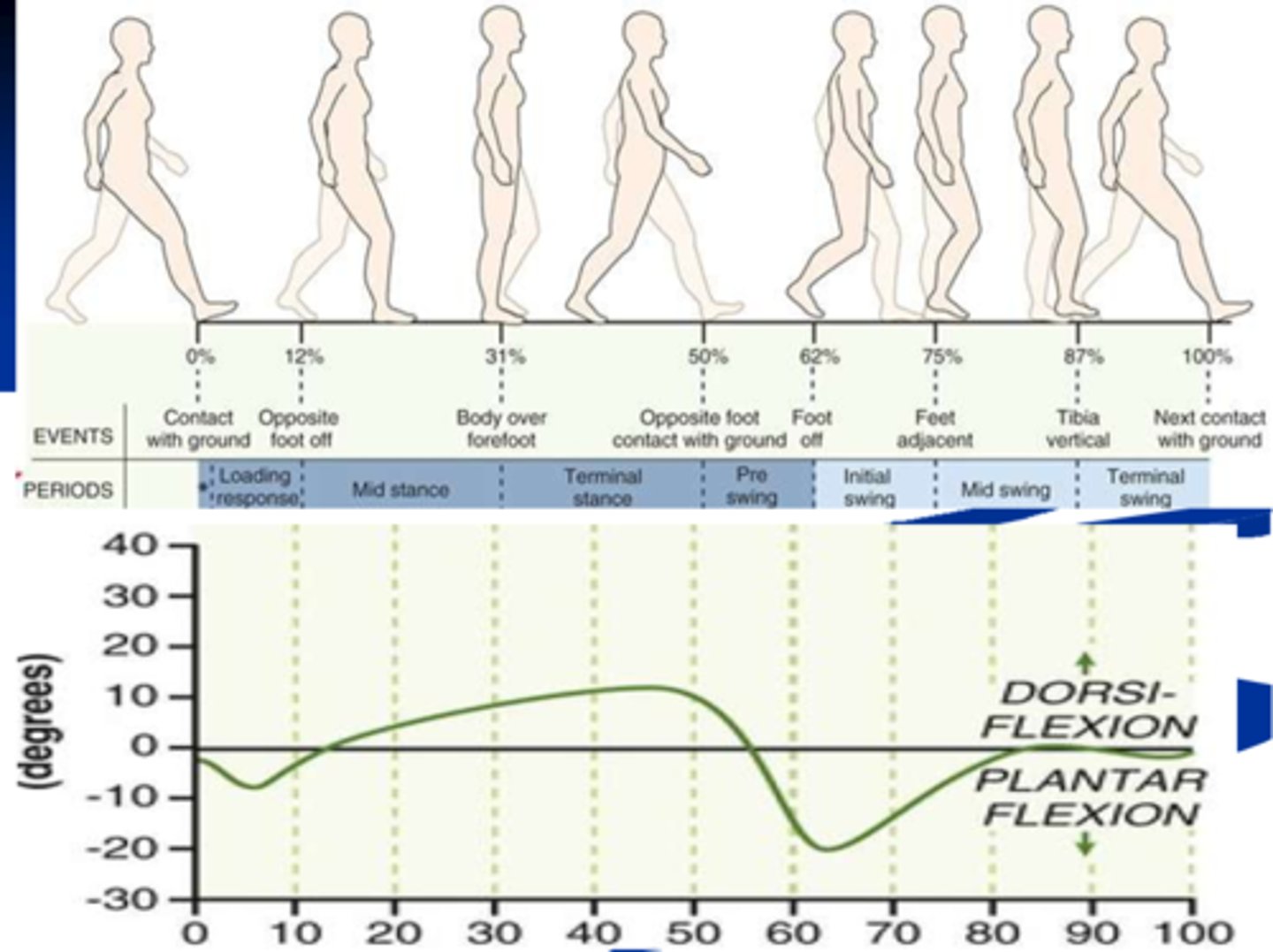
How would a pt with a lack of dorsiflexion compensate during gait?
bouncing, toeing out, foot pronation (moving midfoot and subtalar joint out of way), decreased ability to clear toes during swing phase
What are the kinematics of the first tarsometatarsal in the sagittal plane during gait?
slight plantar flexion and dorsiflexion to help with flexibility and stability of foot's medial longitudinal arch during gait.
What are the kinematics of the first metatarsophalangeal joint (big toe) in the sagittal plane during gait?
from heel off to just before toe off: approximately 45-55 deg of extension
What limitations of great toe extension cause during gait?
limitations can cause excessive toe out and less efficient push off. (can cause problems in other areas)
Summary of Sagittal Plane Kinematics:
-at heel contact, the joints are aligned to reach forward
-controlled knee flexion and ankle plantar flexion cushion for a smooth weight acceptance
-all the joint of the LE then extend to reach a height necessary for the opposite/swing limb to advance
-during swing, all joints shorten the LE for foot clearance
-at terminal swing, the LE again reaches forward
What are the kinematics of the pelvis in the frontal plane during gait?
rotates through a total excursion of about 10-15 degrees as a result of pelvic-on-femoral adduction and abduction on the stance limb
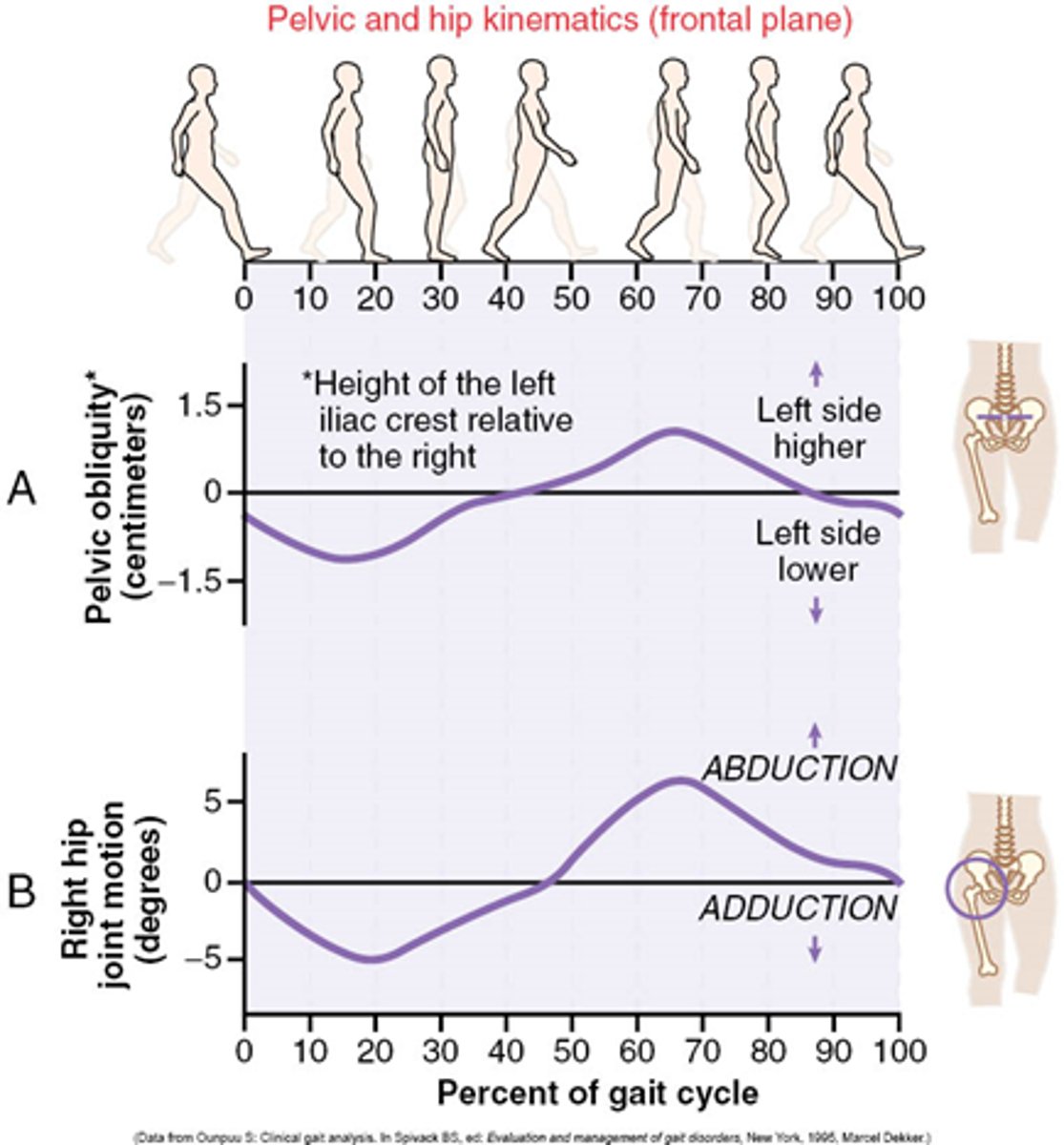
What are the kinematics of the hip in the frontal plane during gait?
elevation and depression of iliac crests contributes to hip abduction and adduction

What may excessive movement of pelvis and hip during gait be due to?
-weakness of the hip abductors
-reduced "shortening" of the swing limb, hip hiking
-discrepancy in limb length
What are the kinematics of the knee in the frontal plane during gait?
relative stable in frontal plane
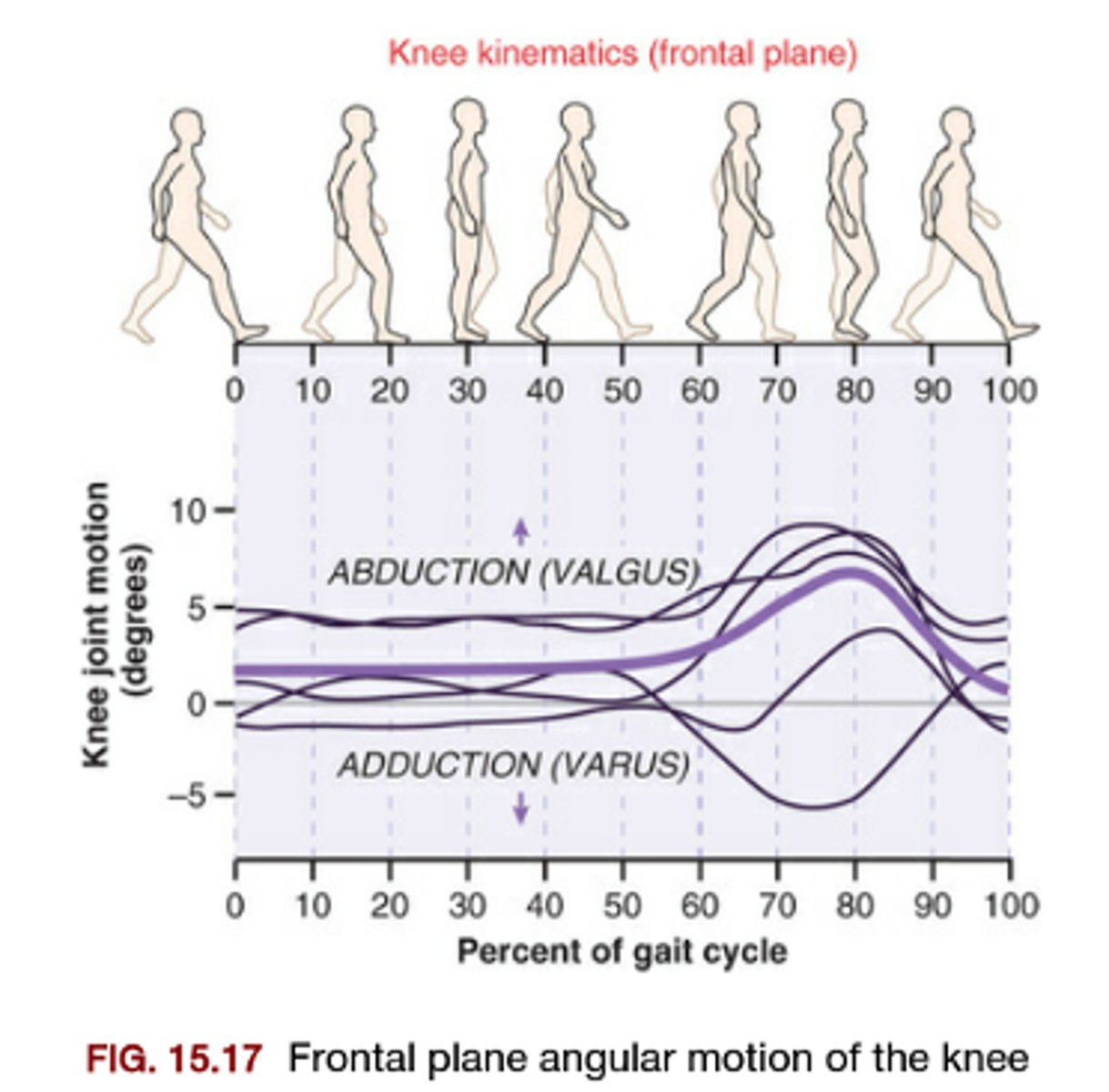
What are the kinematics of the subtalar joint in the frontal plane during gait?
-inverted 2-3 degrees at time of heel contact
-maximal eversion of 2 deg at mid stance
-back to inversion of 6 deg between heel off and toe off
(corresponds to plantar and dorsiflexion)
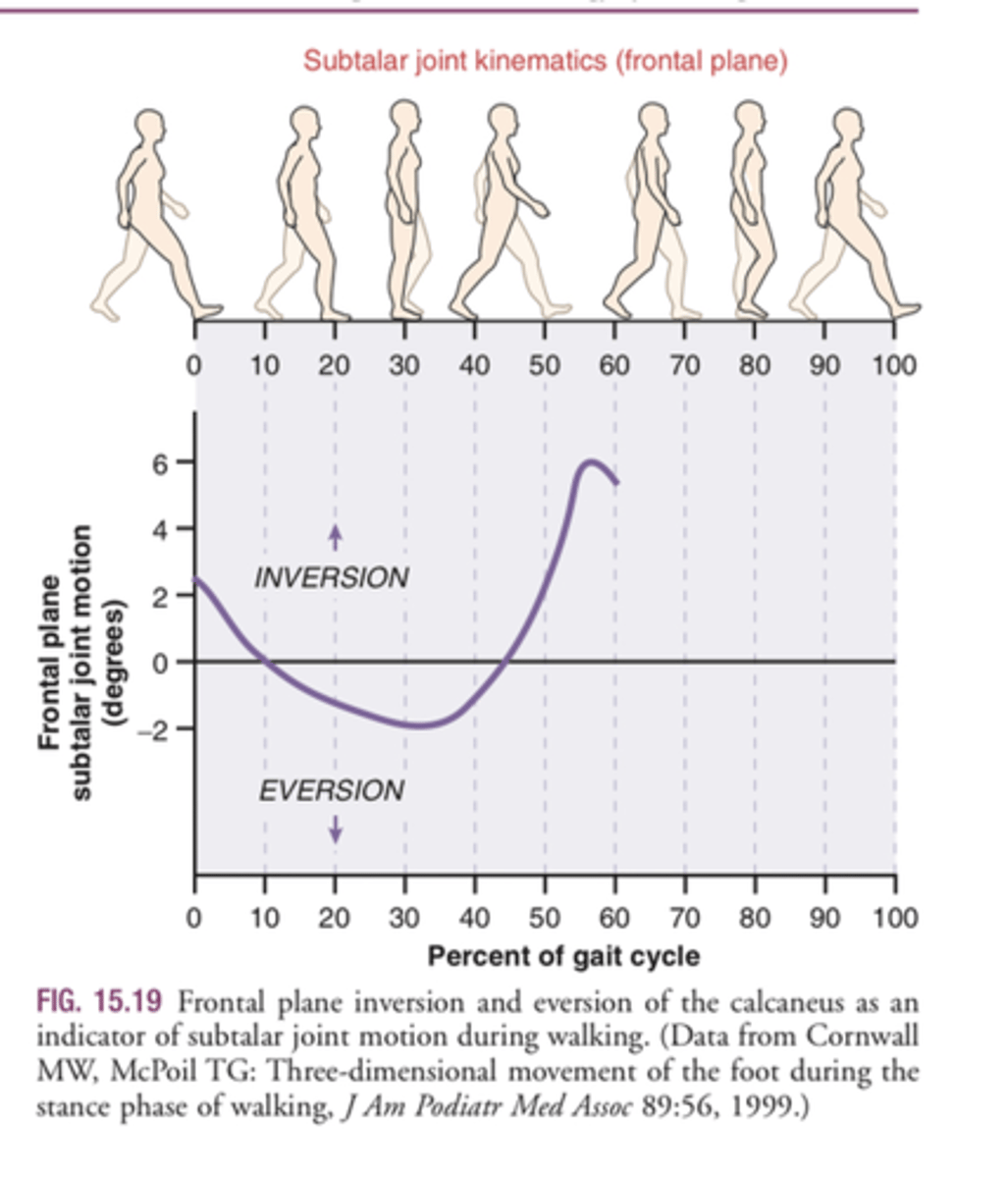
What are the kinematics of the pelvis in the horizontal plane during gait?
rotates 3-4 degrees in each direction
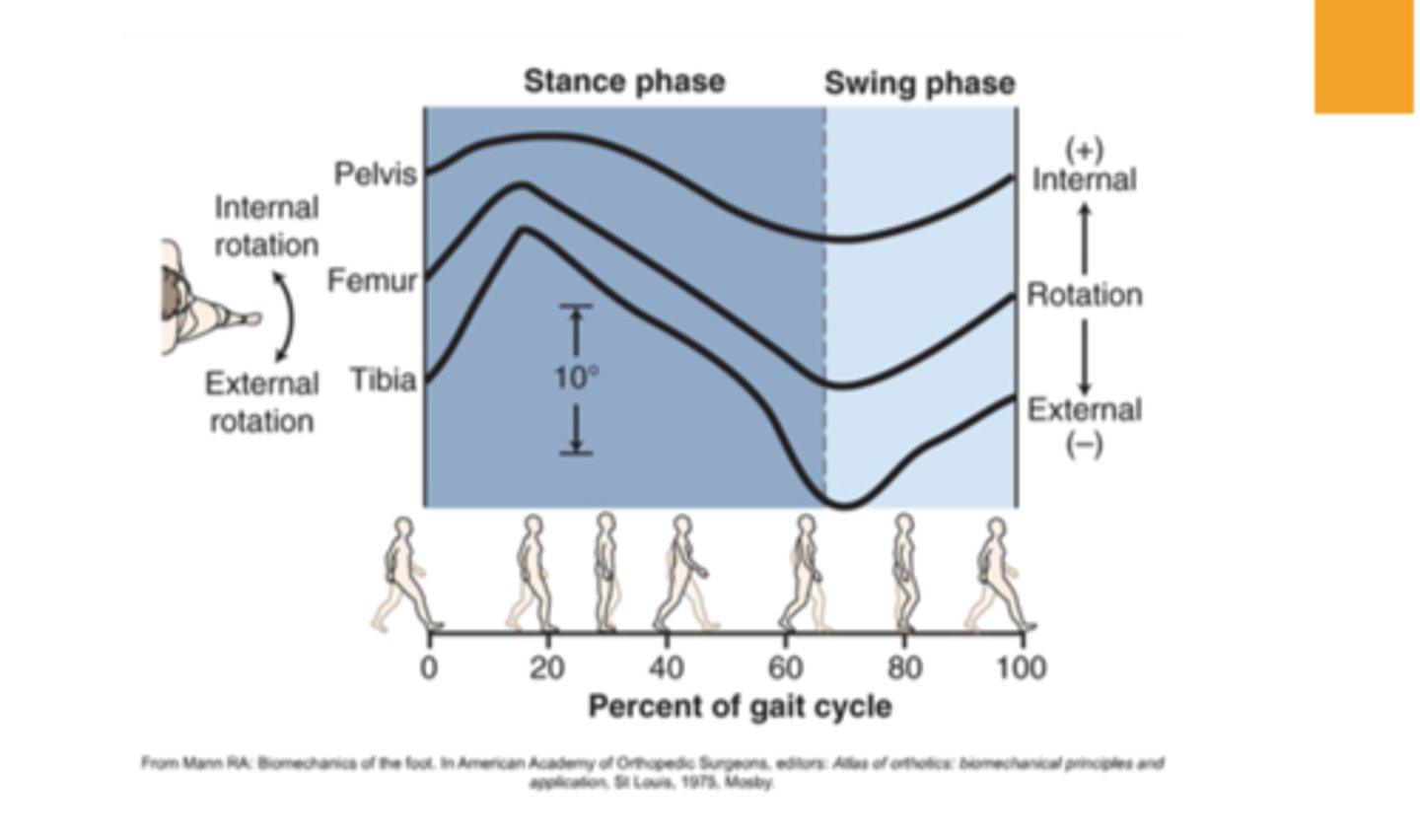
What are the kinematics of the femur in the horizontal plane during gait?
rotates 6-7 degrees in each direction
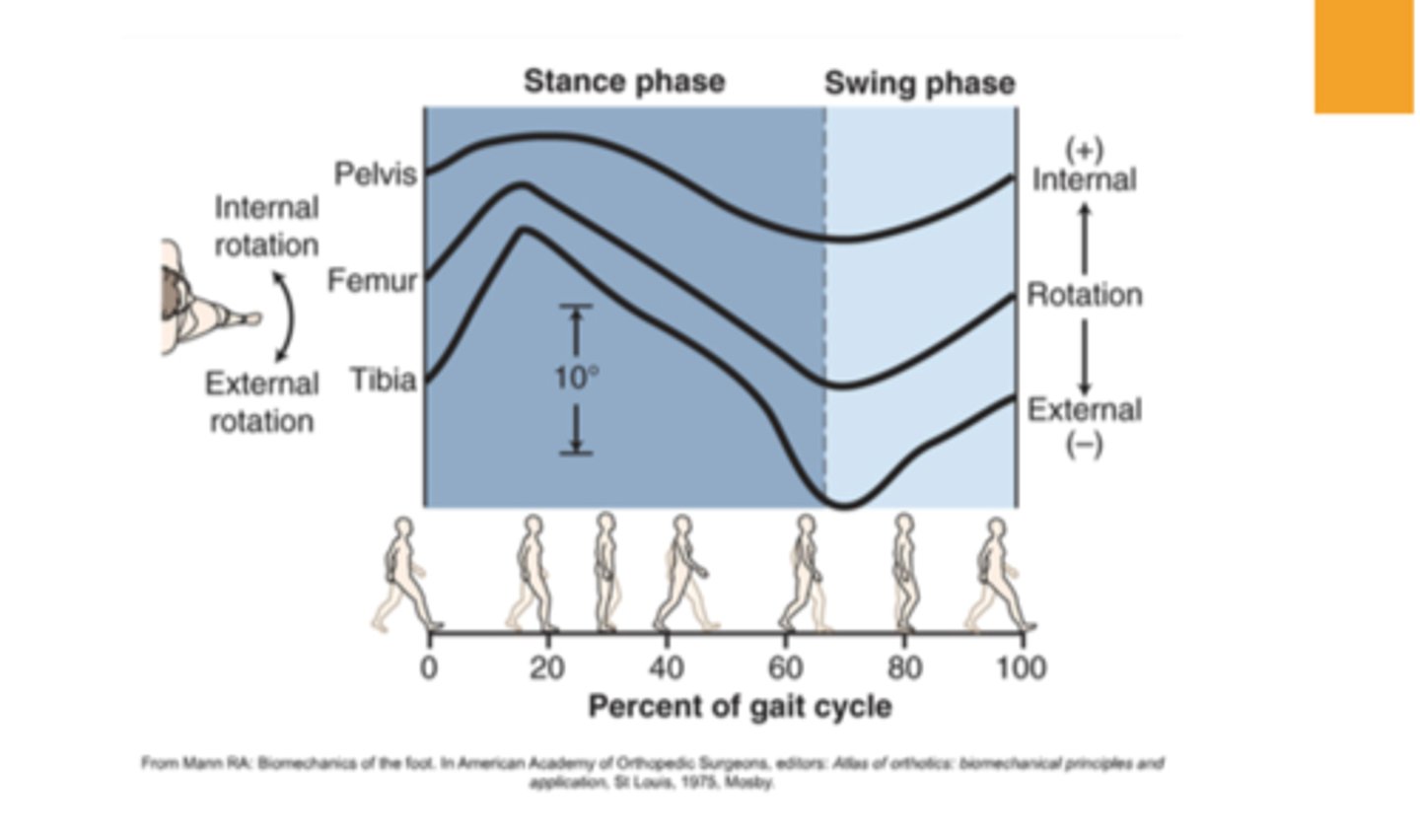
What are the kinematics of the tibia in the horizontal plane during gait?
rotates 8-9 degrees in each direction (screw home mechanism happening)
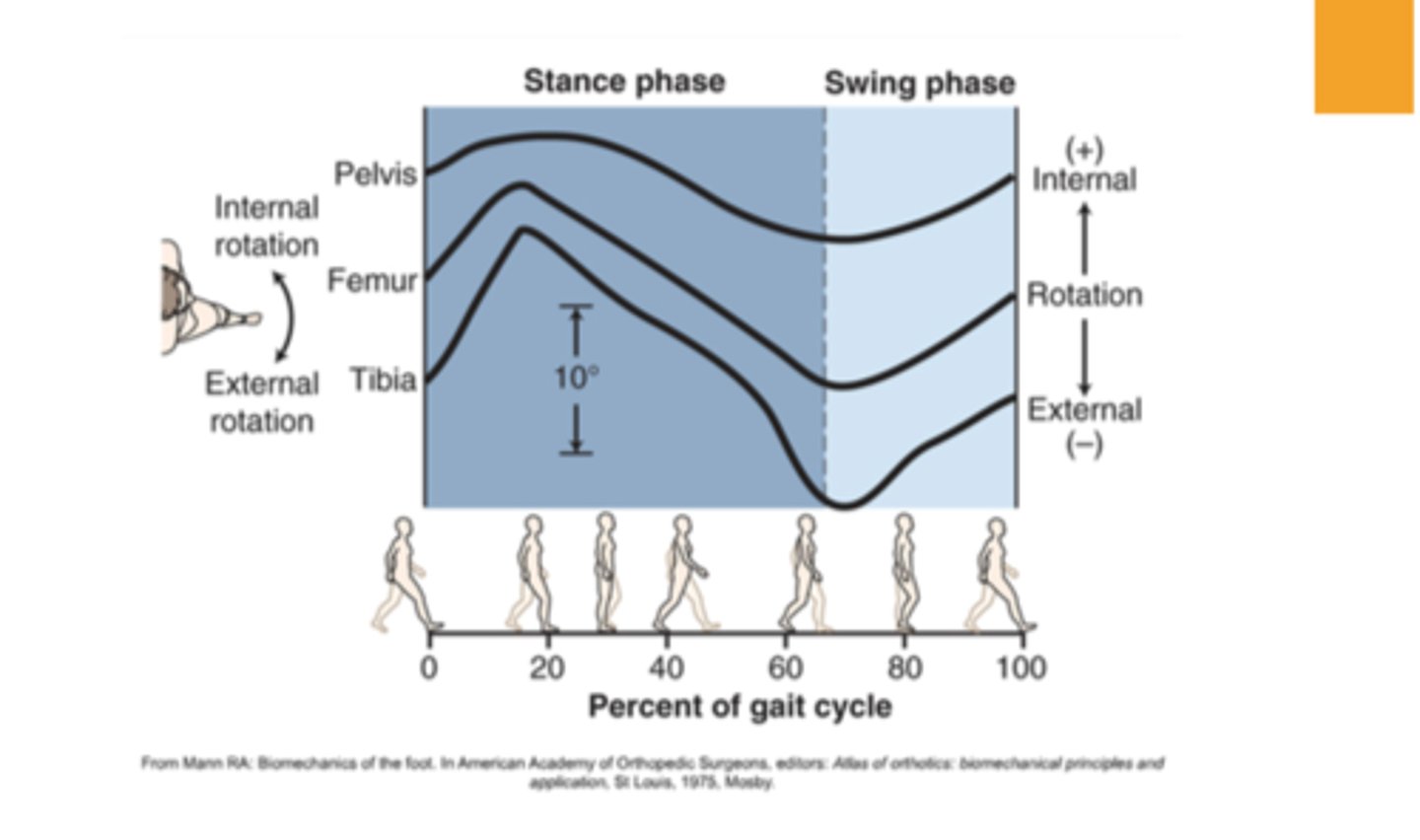
What are the kinematics of the hip in the horizontal plane during gait?
Maximally IR at 50% of gait cycle
ER from 50% of cycle to swing
(don't have to use as much hip and knee flexion. may also be seen as a compensation)
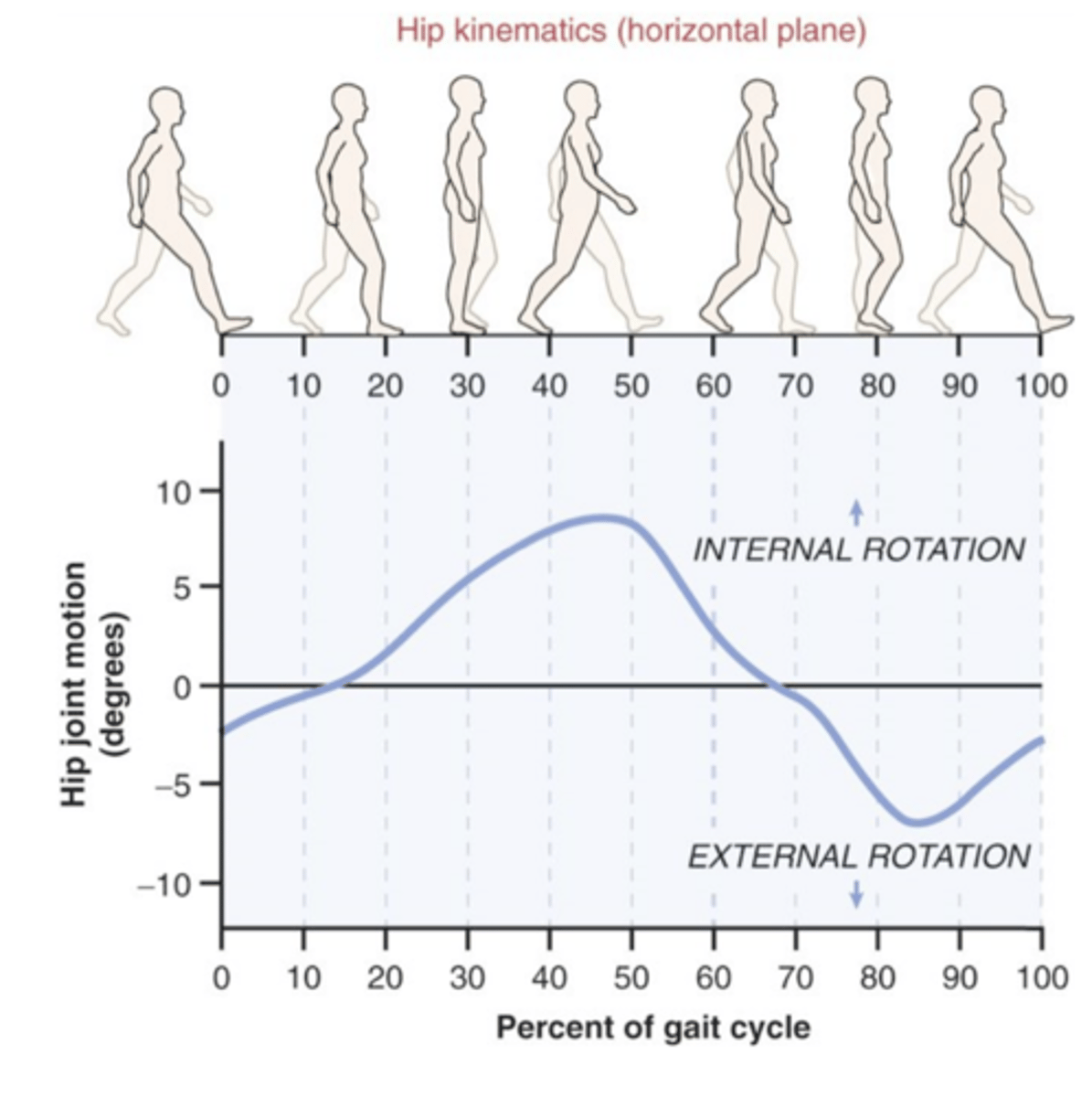
What are the kinematics of the knee in the horizontal plane during gait?
highly variable
What are the trunk and UE kinematics during gait?
-small spinal movements of 3-5 deg in all three planes serve to dampen oscillations due to gait
-the shoulder girdle rotates 7-9 deg opposite of the pelvis
-the shoulder has reciprocal sagittal movement with the hip (25 deg ext to 10 deg flex; amplitude increases with speed)
How is energy expenditure during gait typically measured?
typically measured indirectly by quantifying oxygen consumption
(in gait: cal/kg/m)
During gait, what is conservation of energy achieved by?
-optimizing the excursion of the CoM
(don't want your CoM to move too much)
-controlling the body momentum
(object in motion stays in motion, minimize excessive momentum)
-taking advantage of intersegmental transfers of energy
(use the energy generated by one part of body to propel another)
With gait, when is efficiency greatest
at about 1.33 m/sec (3 mph)
Walking ______ or ______ increases energy cost
faster or slower
Walking speed =
step length x cadence
When is efficiency of walking greatest?
when step length: step rate ratio = 0.0072 m/steps/min for men and 0.0064 m/steps/min for women across all walking speeds
Individuals with abnormal gait patterns tend to walk (slower/faster) to keep the rate of energy consumption at a comfortable aerobic level.
slower
(abnormal gait patterns consume more energy than normal)
What speed is approximately the lowest energy expenditure?
1.33 m/sec or 80m/min
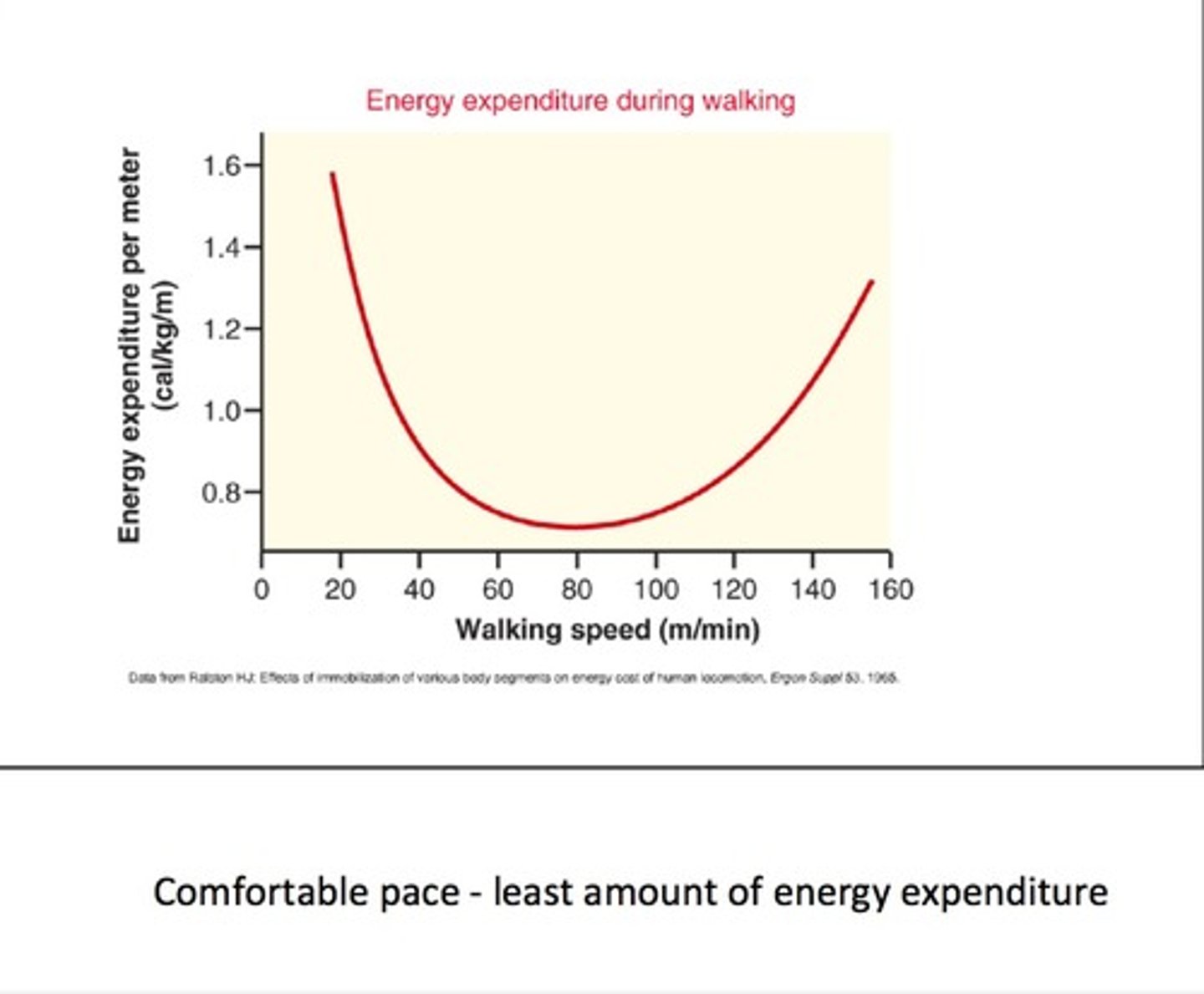
T/F Walking slow is less energy expenditure per meter compared to fast
false
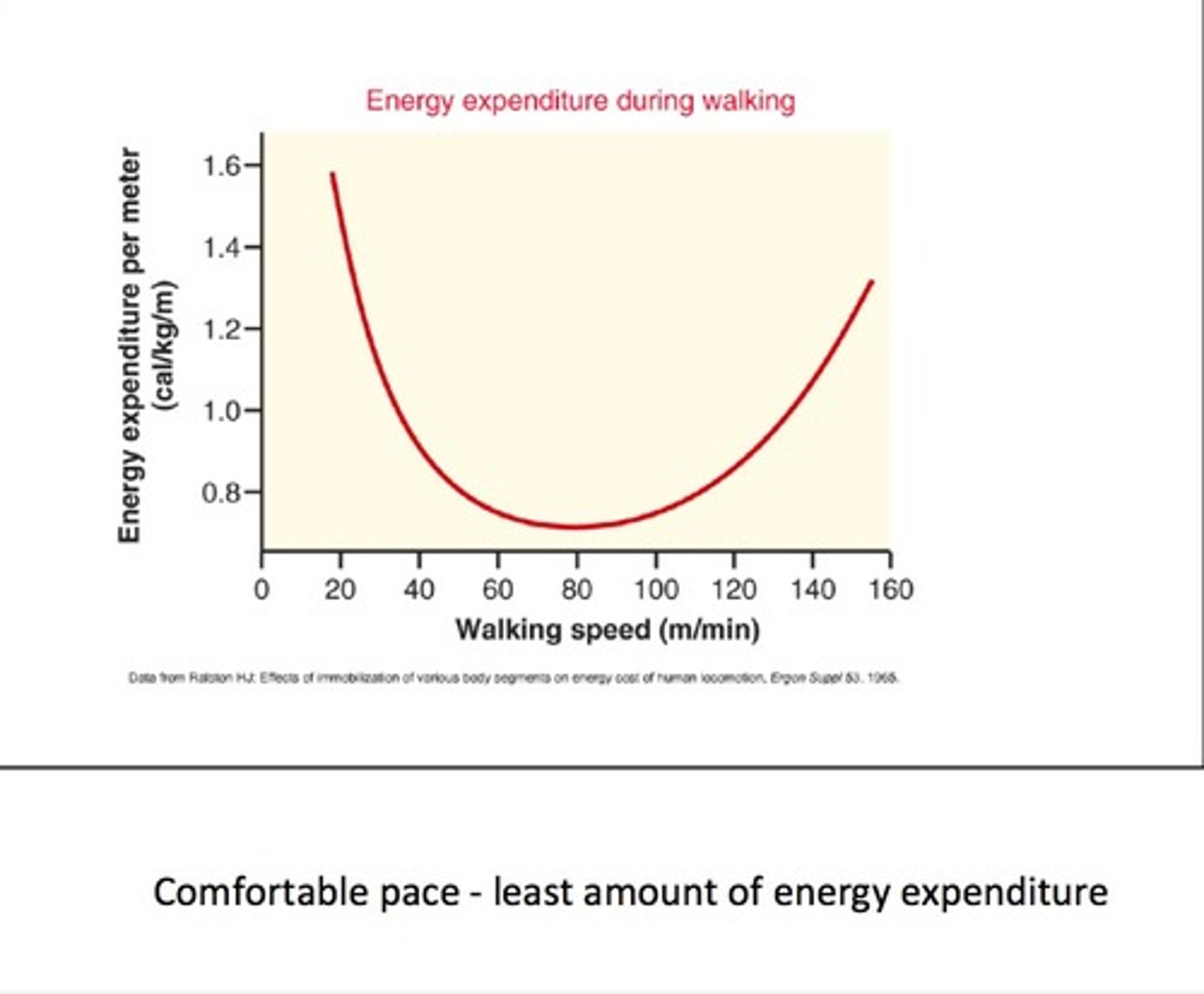
How do the 5 energy saving kinematic strategies of walking work?
5 kinematic strategies serve to reduce/optimize the displacement of the CoM during gait.
Achieved through 2 directions of action - vertical displacement and side-to-side displacement
What is the Horizontal Plane Pelvic Rotation strategy?
Reduces downward displacement of the CoM: horizontal plane rotation of the pelvis advances the entire swing limb forward, minimizing the amount of hip flex/ext needed for a given step
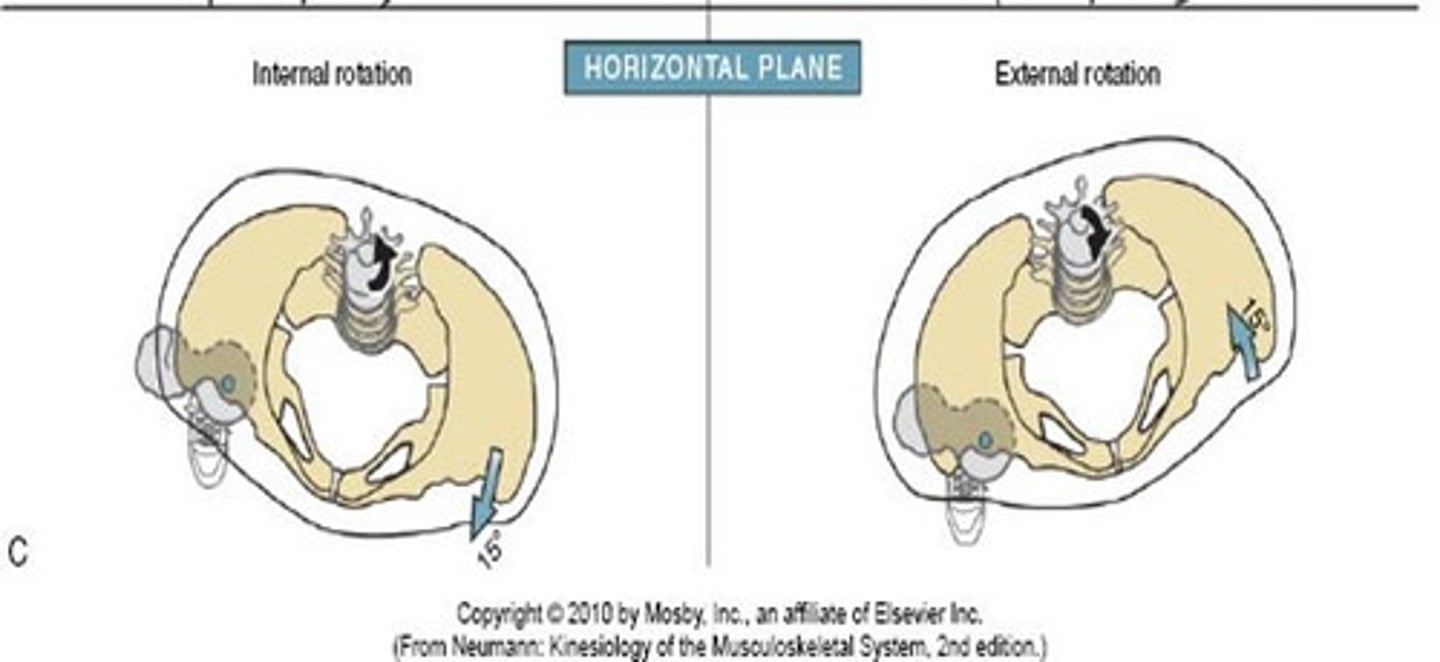
What is the Sagittal Plane Ankle Rotation strategy?
Reduces downward displacement of the CoM: makes use of the ankle-foot complex to elongate the LE. At heel contact the alignment of the ankle places the calcaneus in contact with the ground. Near end of stance the LE is elongated by PF of the ankle (heel rise)
What is the Stance Phase Knee Flexion strategy?
reduces upward displacement of CoM: when the LE is in its most vertical orientation (allows body to drop down some)
What is the Frontal Plane Pelvic Rotation strategy?
Reduces upward displacement of the CoM: during stance phase the contralateral iliac crest falls. Throughout the gait cycle the iliac crests alternately rise and fall like a seesaw. However, the point anterior to S2 (point of the body's CoM) remains stationary.
(keeps CoM in middle)

What is the Frontal Plane Hip Rotation strategy?
Reduces the side-to-side excursion of the CoM. Amplitude of lateral displacement, partially seen in step width, is mainly a function of frontal plane hip motion (abd and add).
Decreased dynamic BOS = less stability (likely represents a mechanical compromise between energy conservation and stability). Those with balance disorders often choose to walk with wider BOS to improve stability, thus increasing energy expenditure.
T/F Throughout the gait cycle, nearly all LE muscles exhibit short bursts of electrical activity (100-400 msec).
True
What does knowing when muscles are active during gait allow for?
Allows for better understanding and treatment of gait deviations
When is a muscle considered to be "on" during gait?
Muscle considered "on" if amplitude of EMG reaches a predetermined value above resting, otherwise it is "off." (for average walking velocity of 1.37 m/sec)
When is the erector spinae "on" during gait? What does it control?
(heel contact)
1st: just prior to heel contact to about 20% of the gait cycle.
2nd: from 45-70% of the gait cycle, which corresponds to opposite heel contact.
Controls the forward angular momentum of the trunk (keeps you upright) - so if a pt has excessive forward lean during gait - test the lumbar extensors!
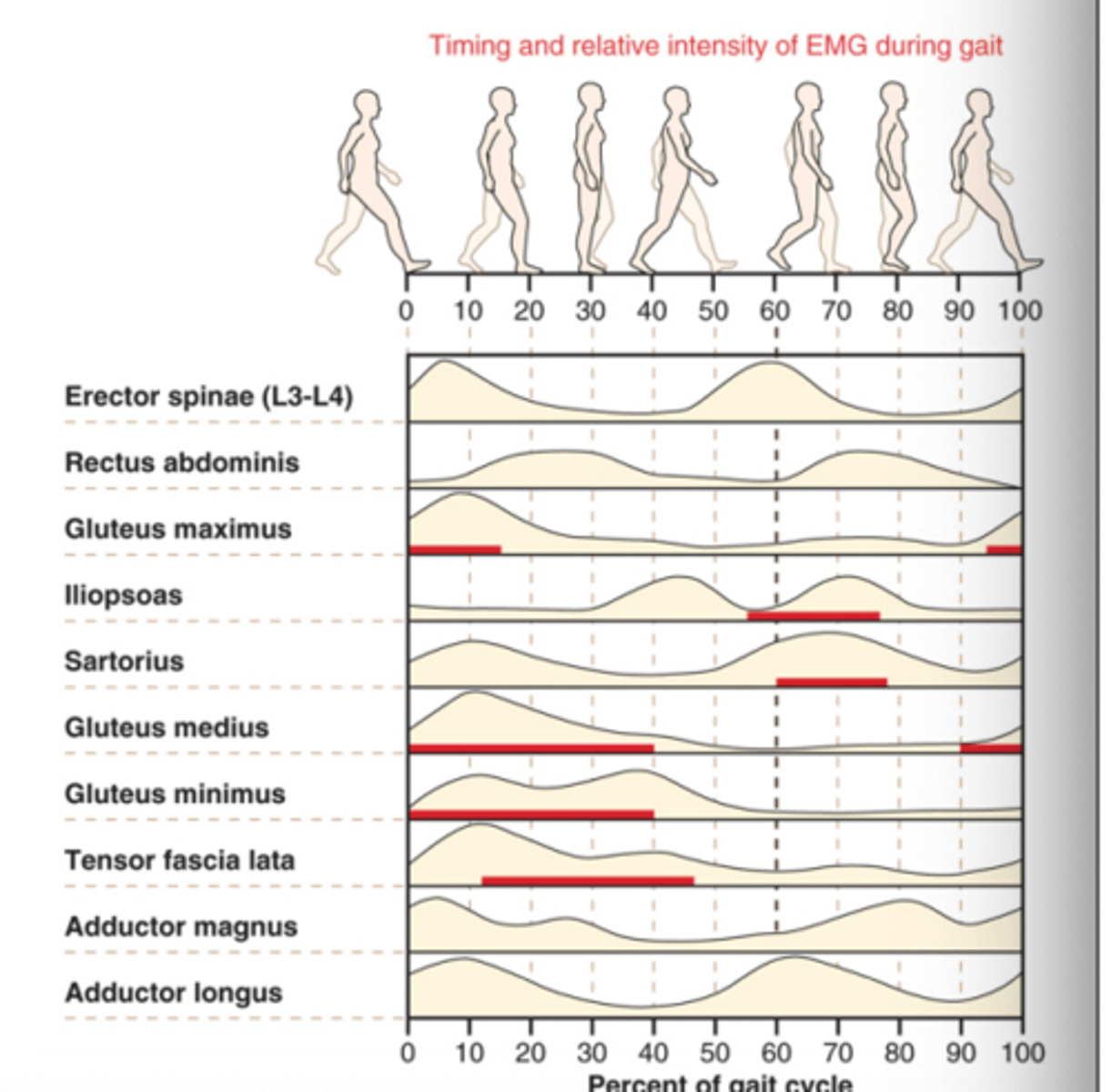
When is the rectus abdominis "on" during gait? What does it control?
Increased activity when the hip flexors are actively flexing the hip, between 20% and 40% and again at 70% and 90% of the gait cycle.
Stabilizes the pelvis and lumbar spine
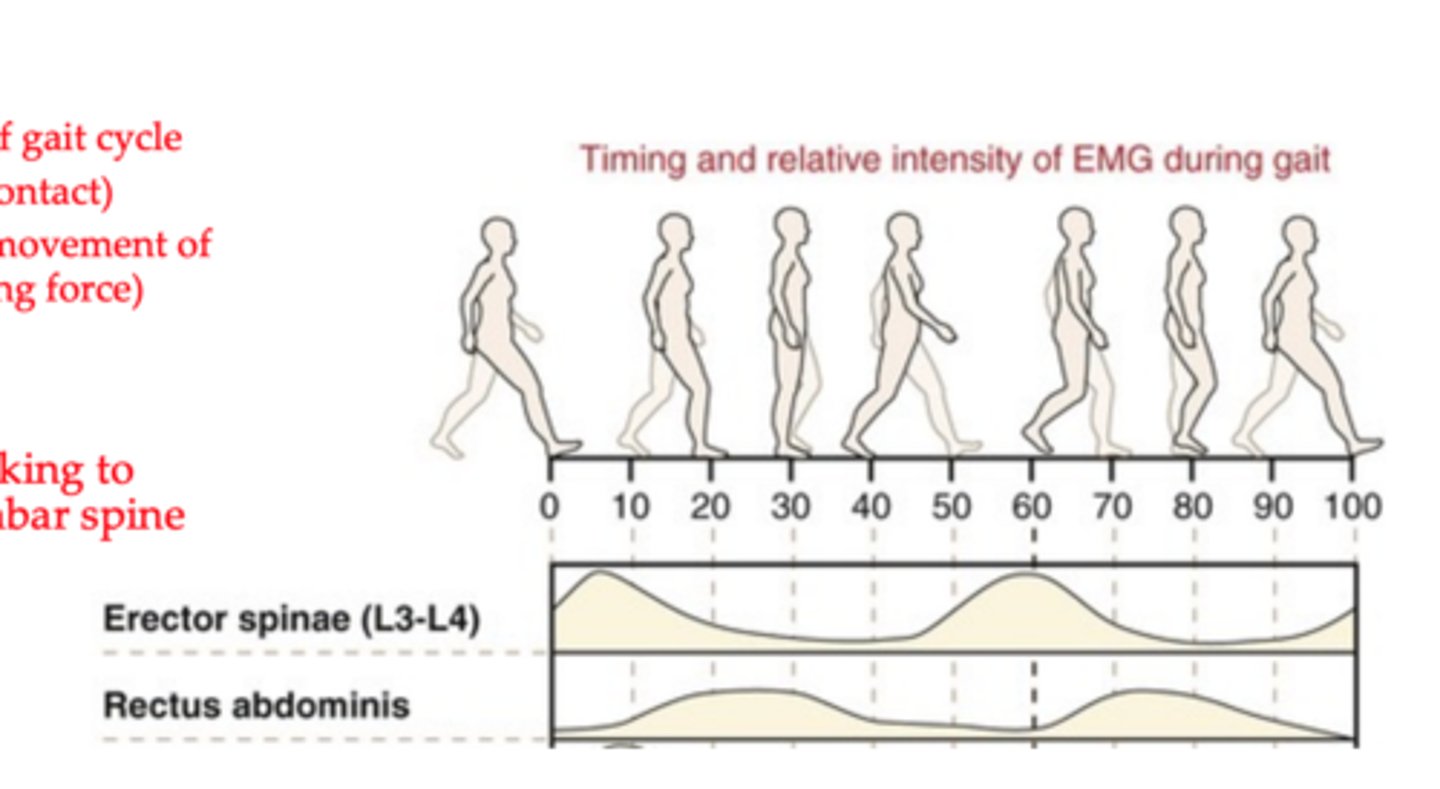
When is glute max "on" during gait? What do they prevent?
Terminal swing through heel contact and midstance
Begins at terminal swing to initiate hip extension and prepare the musculature for weight acceptance at the beginning of stance (prevents jackknifing of the trunk)
Remains active from heel contact to midstance
Largely inactive in swing phase until terminal swing.
(Hamstrings are active during first 10% of the gait cycle for similar reasons)
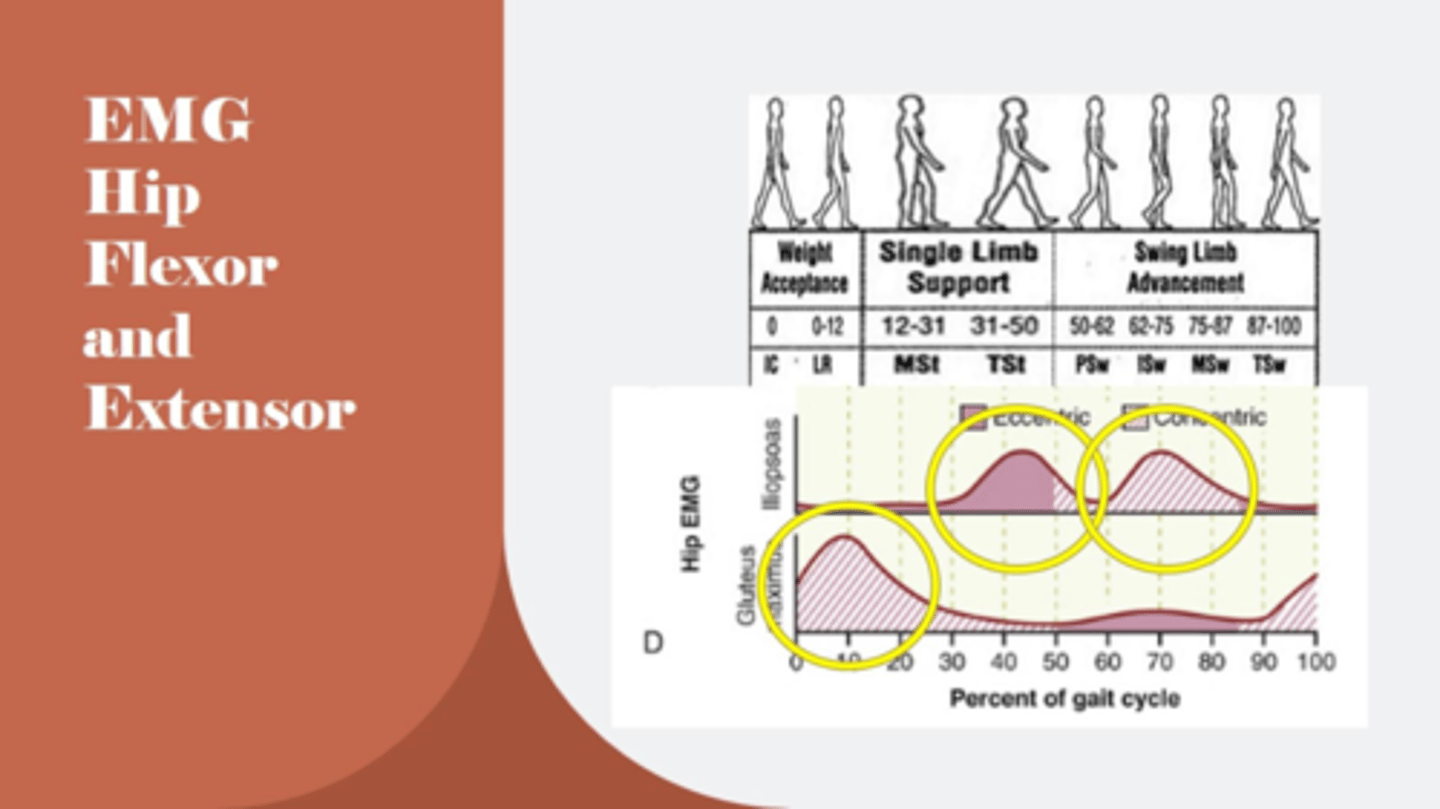
When are the hip flexors "on" during gait? What are their key roles?
Primarily iliopsoas, but assisted by rectus femoris - become ECCENTRICALLY active before toe off
Active only in the first half of swing phase, second half of swing is the result of forward momentum of the thigh
Key roles - advance the LE forward during swing and lift the LE to allow for toe clearance during swing
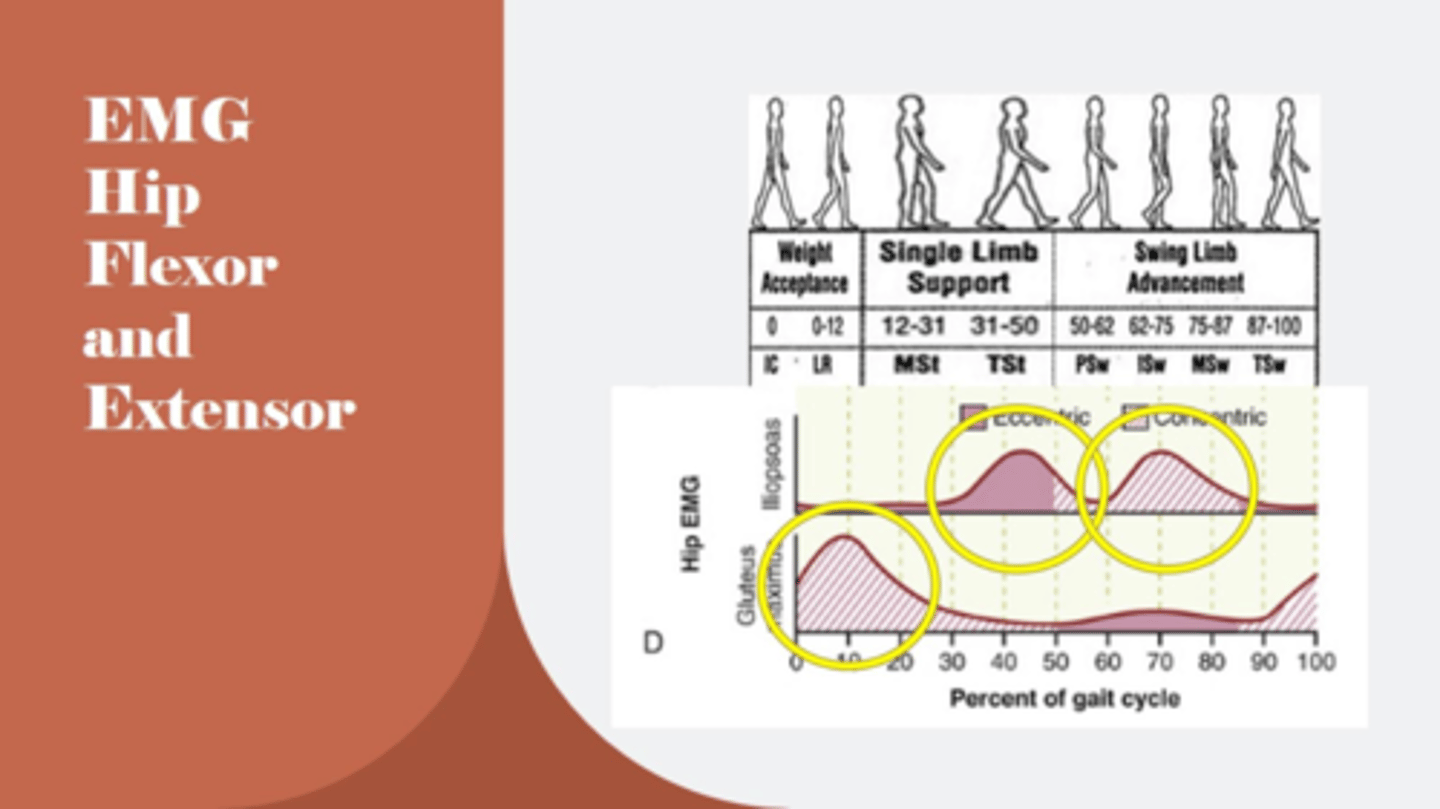
The hip abductors stabilize the pelvis in the _______ plane
frontal
What do the hip abductors control during gait?
Hip abductors control the slight lowering of the contralateral pelvis and the alignment of the femur in the frontal plane.
What may inadequate activation of the hip abductors during gait result in?
Inadequate activation may result in excessive adduction of the femur and excessive valgus torque at the knee
When are the hip abductors (glute med and min) "on" during gait?
Most active during the first 40% of the gait cycle, especially during SINGLE LIMB SUPPORT (and swing phase) Hip abductors active during opposite limb swing phase.
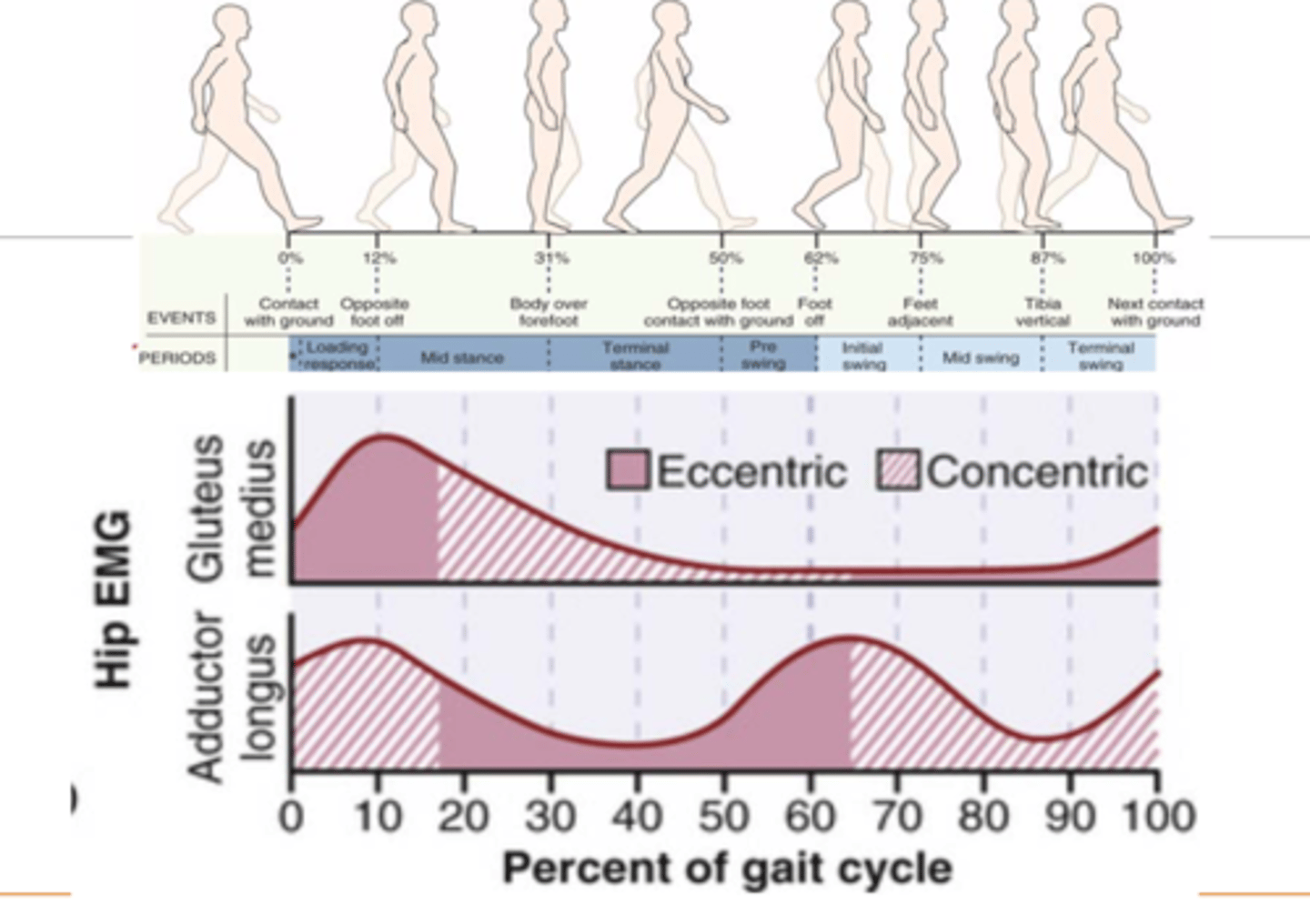
How could weak hip abductors be responsible for medial knee pain?
If you observe a Trendelenburg gain pattern - pt is putting increased load on medial side of the knee therefore strengthening glute med may help with the medial knee pain
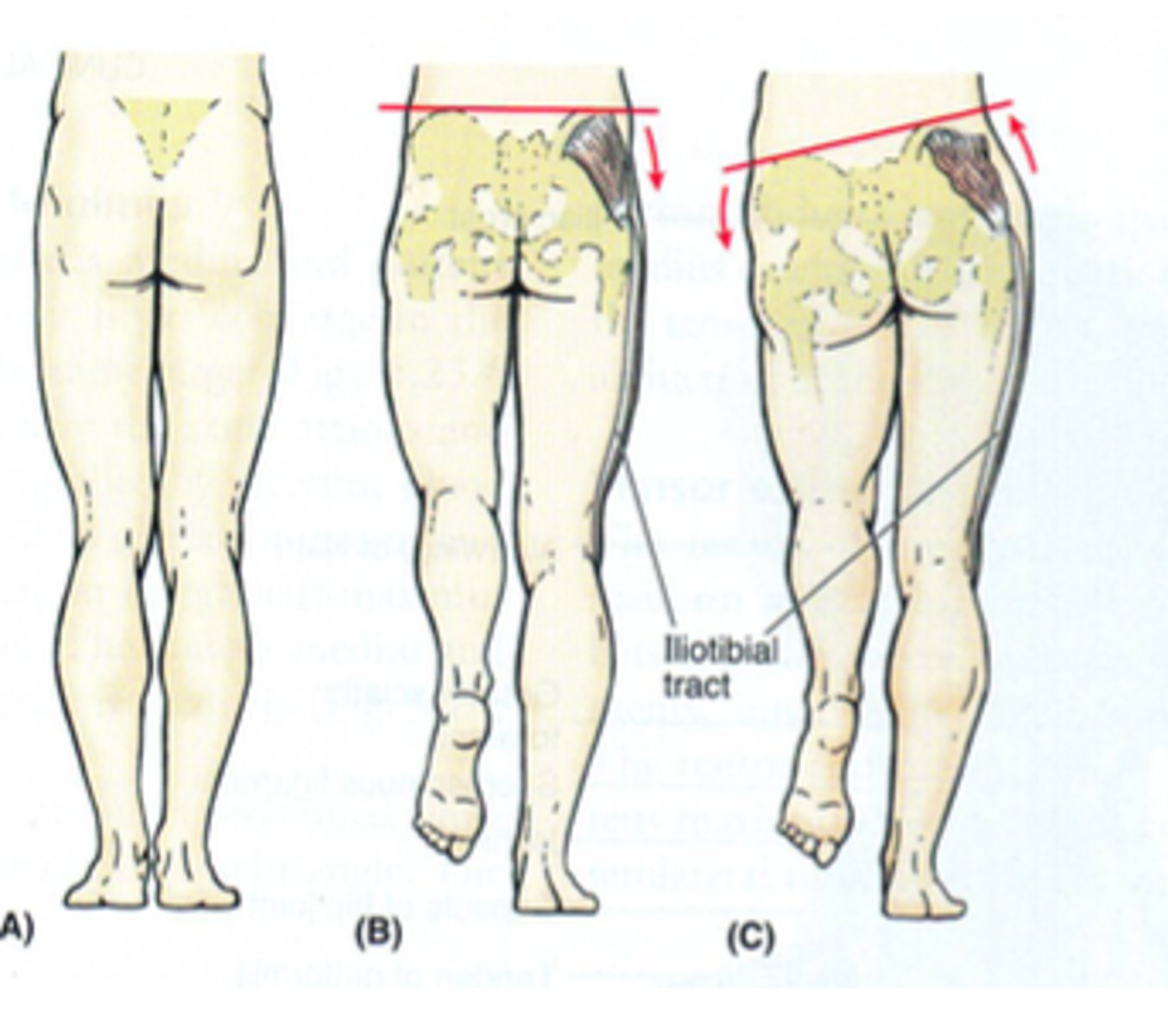
What are the other roles of gluteus medius during gait?
-active toward very end of swing phase in preparation for heel contact
-anterior fibers assist with hip flexion and IR
-posterior fibers assist with hip ext and ER

When are the hip adductors "on" during gait?
Two bursts of activity during gait:
1st - occurs at HEEL CONTACT to stabilize the hip through coactivation with the hip extensors and abductors.
2nd - occurs just AFTER TOE OFF to assist with initiation of hip flexion
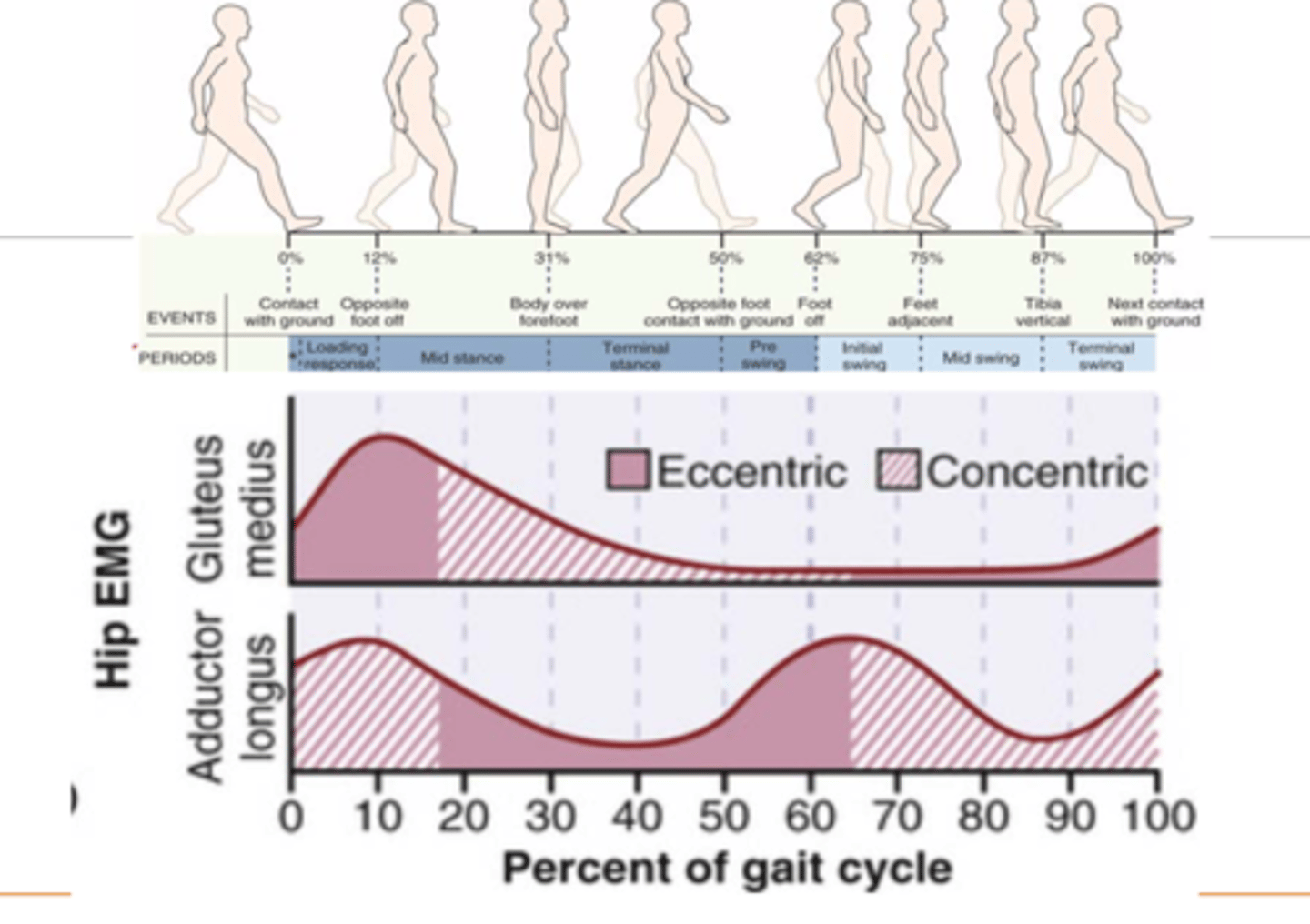
What are the roles of the hip internal rotators during gait?
Active throughout much of the STANCE PHASE
Move the CONTRALATERAL side of the pelvis forward in the horizontal plane. Assist with advancement of the swing limb.
When are the hip external rotators most active during gait?
During early stance phase
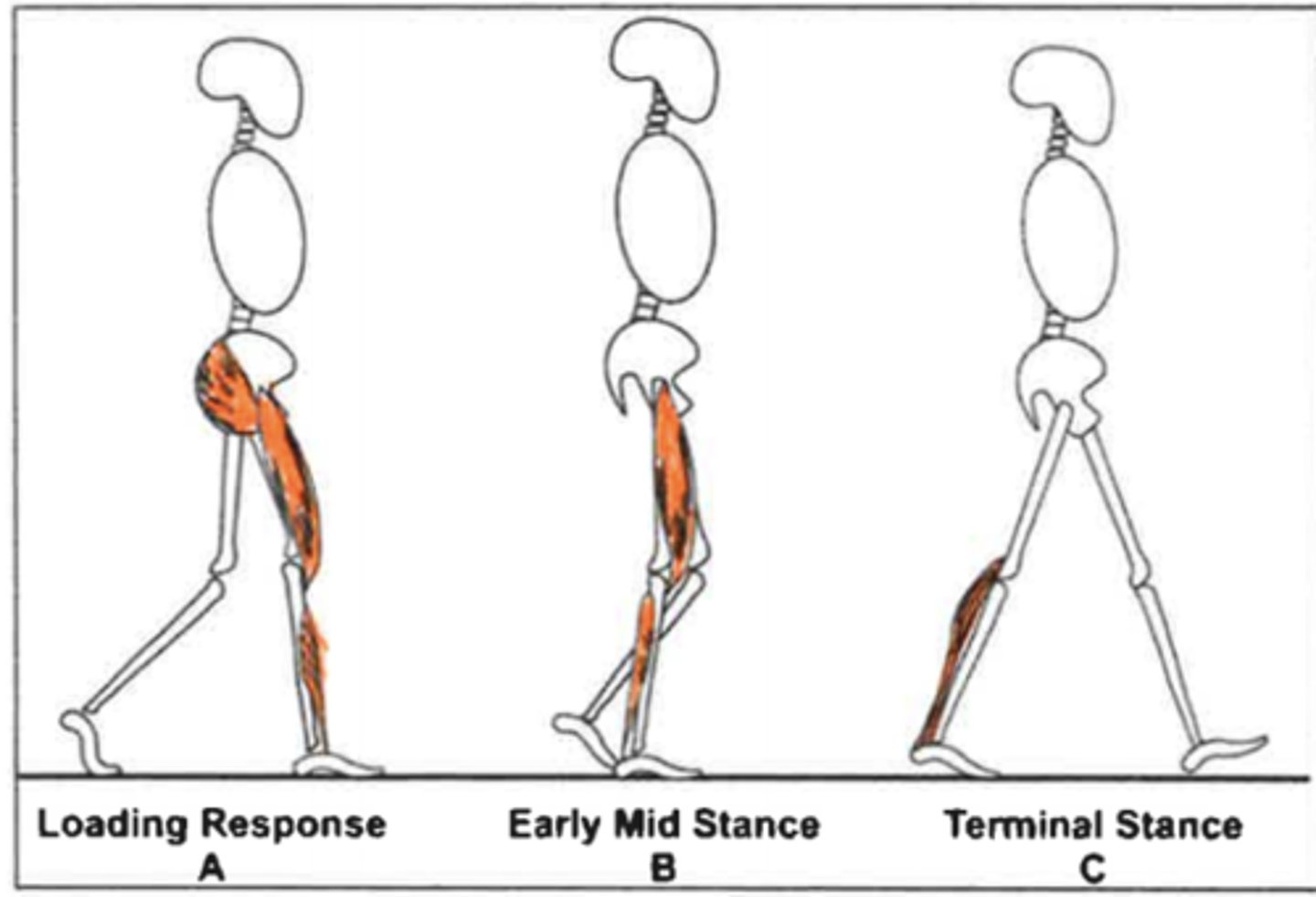
What do the hip external rotators work in conjunction with the internal rotators to do?
Work in conjunction with the internal rotators to CONTROL ALIGNMENT of the hip in the HORIZONTAL PLANE. Control pelvic rotation while the lower limb is fixed.
What type of activation in the hip external rotators is important to the control of IR of the lower limb in early stance?
Eccentric activation
What may inadequate strength or control of the hip external rotators result in?
Inadequate strength or control may result in excessive IR of the femur, often seen in conjunction with excessive foot pronation
If you put your foot down with too much internal rotation you will move into _________
pronation
Your pt is a runner with knee and ankle pain. You observe that they pronate when they land. What may be a possible cause of their knee and ankle pain?
weakness of hip external rotators
When are the knee extensors "on" during gait?
Quadriceps active in the VERY LATE STAGE of SWING phase in preparation for heel contact.
Major burst of activity occurs shortly after heel contact - CONTROLS the knee flexion in the first 10% of the gait cycle.
Act CONCENTRICALLY to extend the knee and support the weight of the body during mid stance.

What does the eccentric activation of the knee extensors serve to do?
Eccentric activation serves to cushion the rate of weight acceptance on the LE and to prevent excessive knee flexion (controls the knee flexion in the first 10% of the gait cycle)
When are the knee flexors most active during gait?
Hamstrings are the most active from JUST BEFORE to JUST AFTER HEEL CONTACT.
Before heel contact - decelerate knee extension for foot placement.
Initial 10% of stance - active to assist with hip extension and provide stability to the knee through coactivation.
Short head of biceps femoris may also assist with knee flexion during the swing phase.
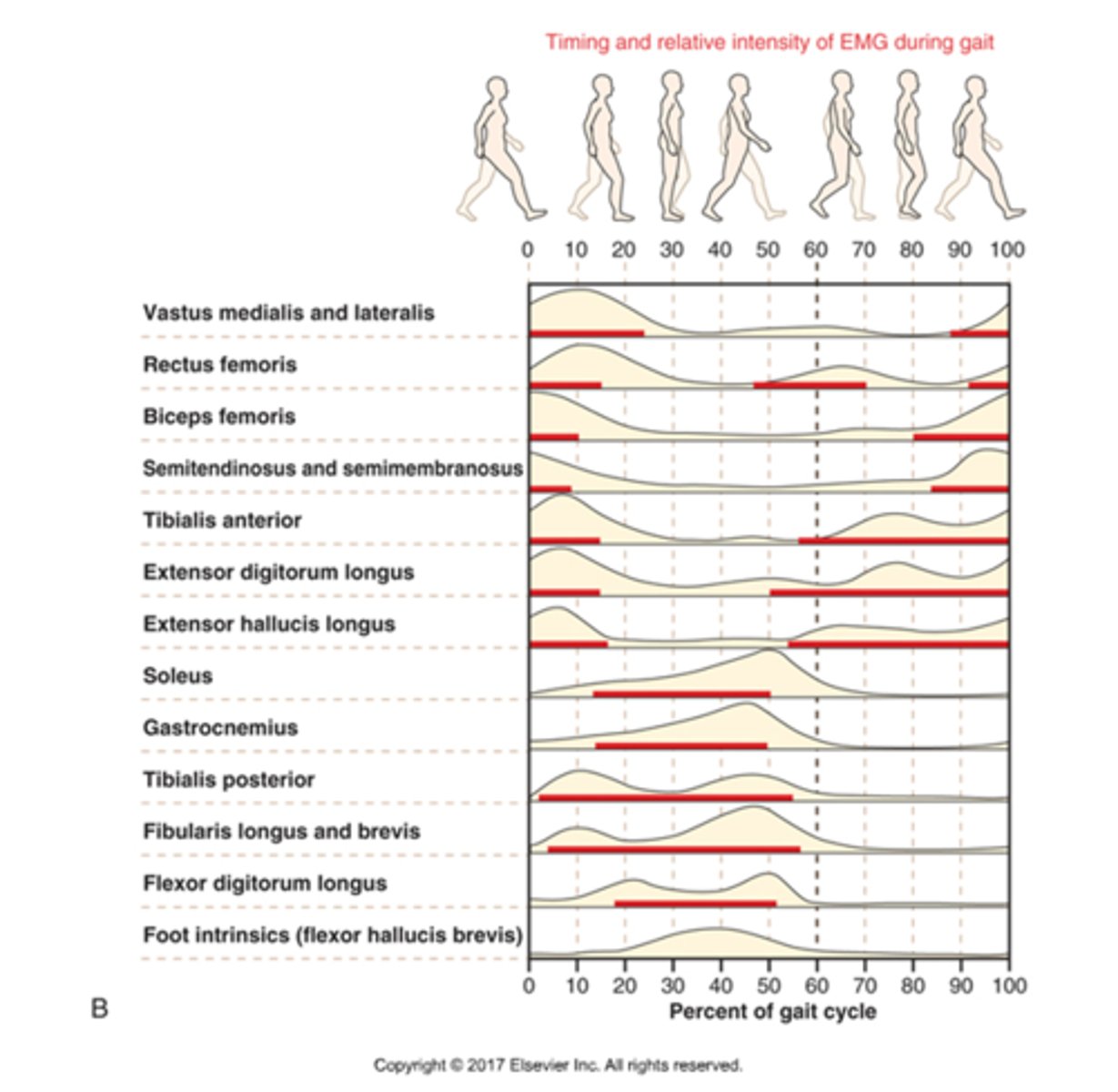
What are the two periods of activity of the tibialis anterior during gait?
heel contact and swing phase
At heel contact, there is a (concentric/eccentric) of the tibialis anterior.
eccentric. strong eccentric activation to decelerate passive PT. From heel contact to foot flat, tibialis anterior may also assist with decelerating pronation.
What is the tibialis anterior role during swing phase?
Tibialis anterior has to produce sufficient DF of the ankle to clear the toes from the ground
What does extreme weakness of the tibialis anterior result in? What are compensations for weak tibialis anterior?
Extreme weakness of the TA results in "drop foot" during swing phase.
Compensated with increased hip and knee flexion, hip hiking, hip circumduction on swing limb, or vaulting (stance side)
What are the actions of the extensor digitorum and extensor hallucis longus during gait
-decelerate PF of the ankle at heel contact
-Assist with DF of the ankle and extend the toes during swing phase
-minor activity during push off may provide stability to the ankle through coactivation with the ankle plantar flexors
The ankle plantar flexors (soleus and gastrocnemius) are active throughout most of _____ phase
stance
The ankle plantar flexors (soleus and gastrocnemius) are active throughout most of stance phase EXCEPT during what part?
except during the first 10%
From 10% of the gait cycle to heel off, ankle plantar flexors ___________ control dorsiflexion
eccentrically
There is a major burst of activity of of the ankle plantar flexors that occurs near _______ and decreases rapidly at ______
major burst near heel off and decreases rapidly at toe off
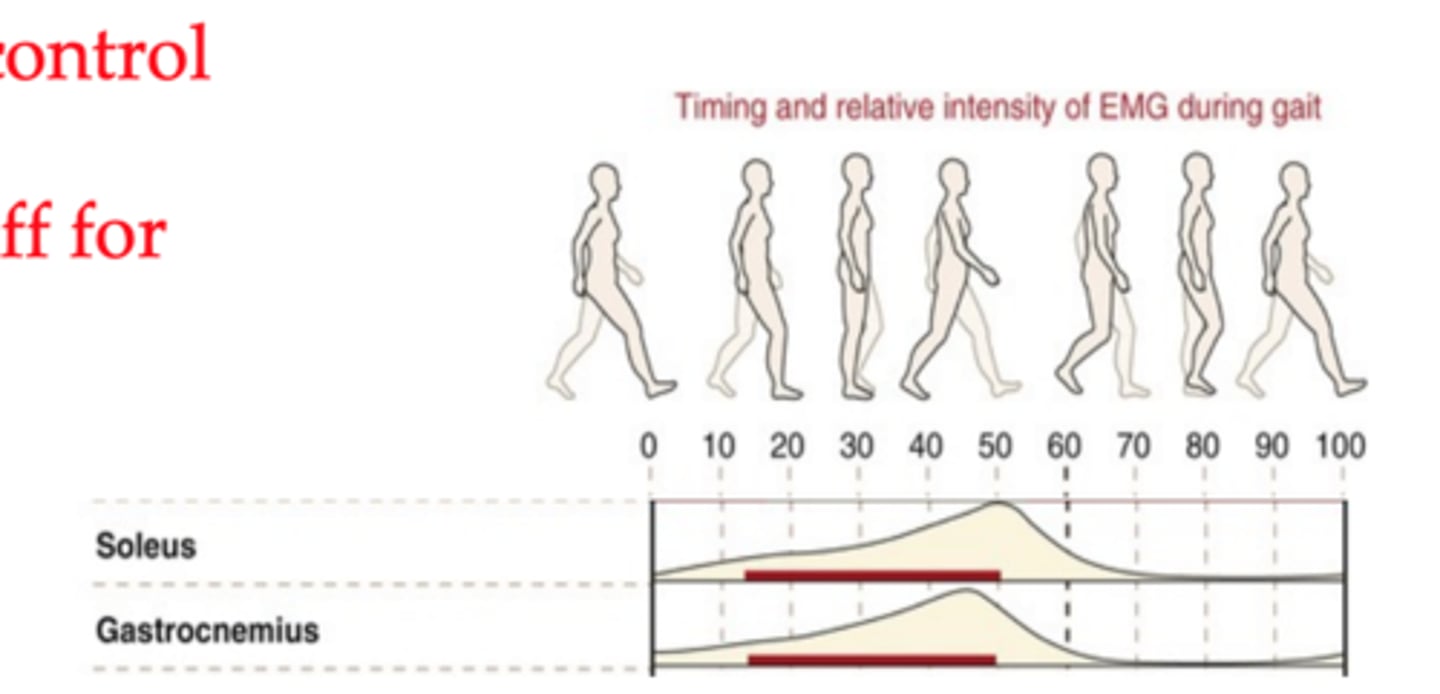
What happens with the ankle plantar flexors during push off?
shortening of the ankle plantar flexors which creates an ankle PF torque that helps with forward propulsion of the body
When is the tibialis posterior active during gait cycle?
Active from 5%-55% of the gait cycle
-decelerates pronation 5%-35%
-supinates from 35%-55% (mid stance - toe off)
-acts on both the foot and tibia throughout mid and late stance phase of gait
What deviation would be seen during gait if tibialis posterior was inadequate?
excessive pronation
When are fibularis brevis and longus active during gait?
Active from 10% to just before toe off.
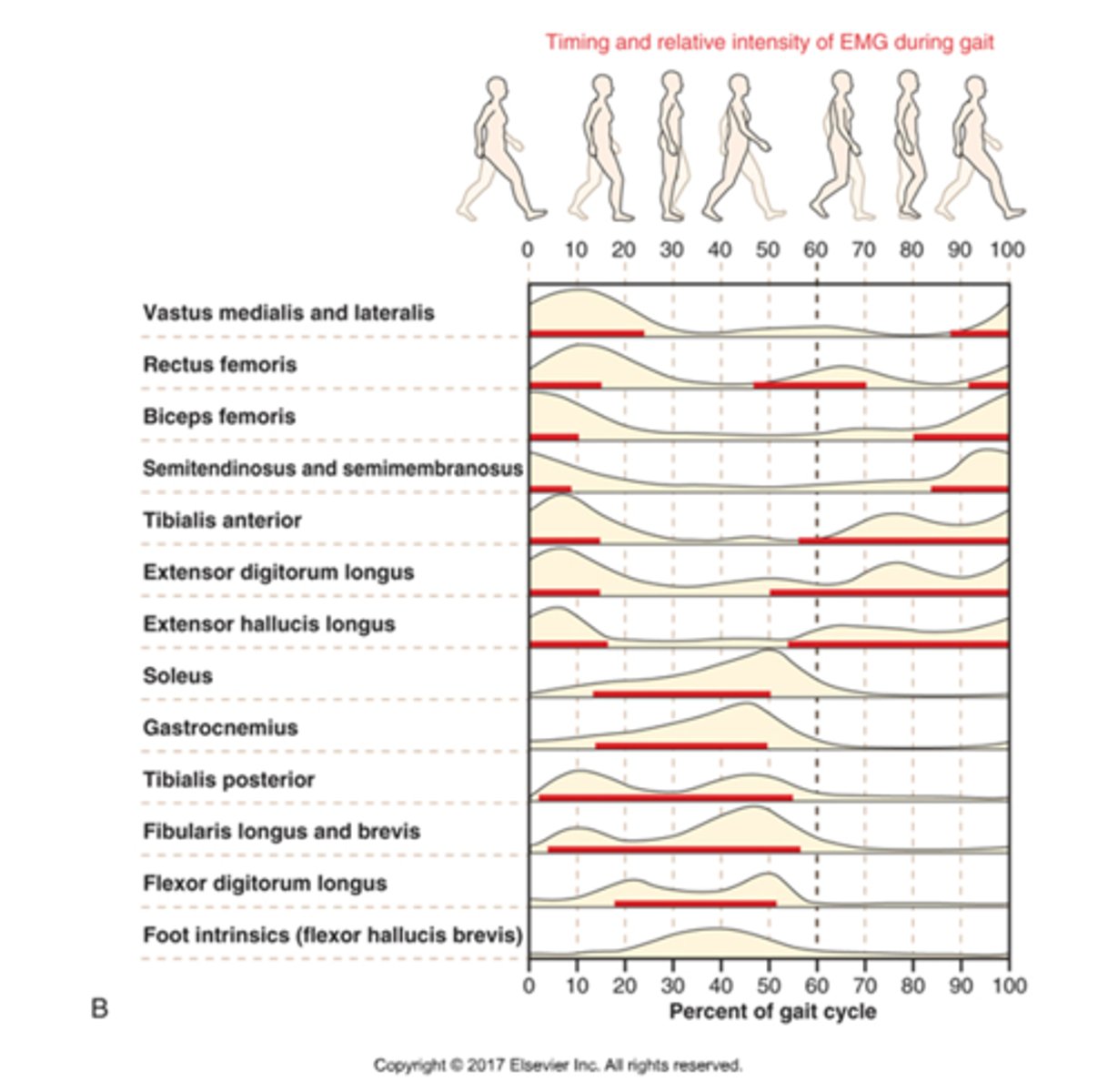
What does fibularis brevis and longus counteract during gait
Counteract the strong inversion of deep posterior muscles